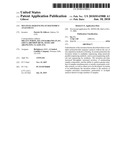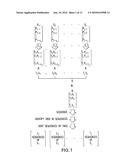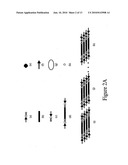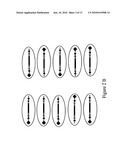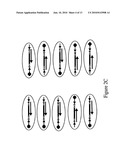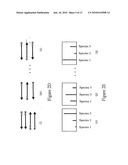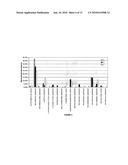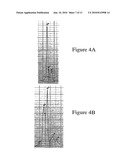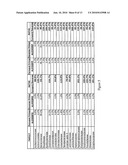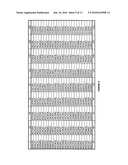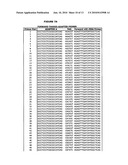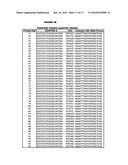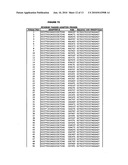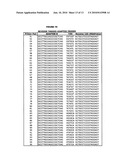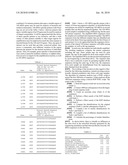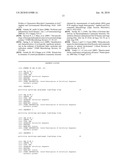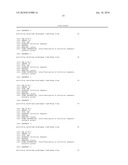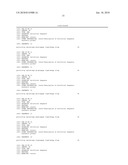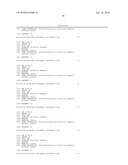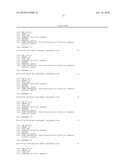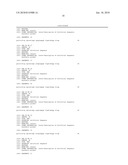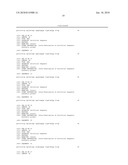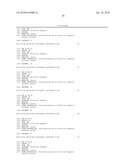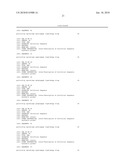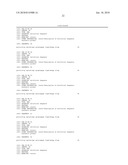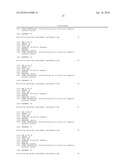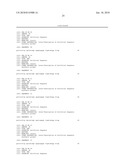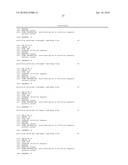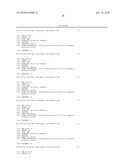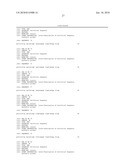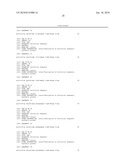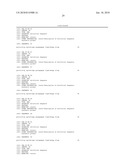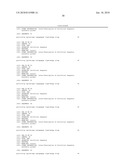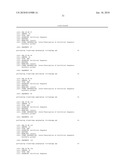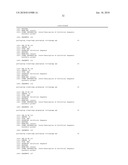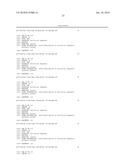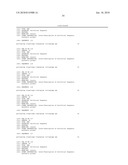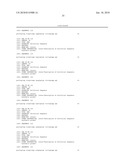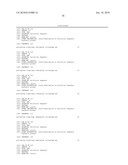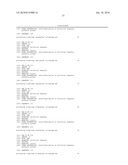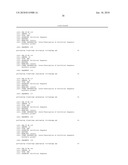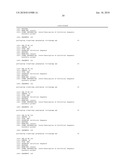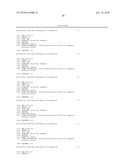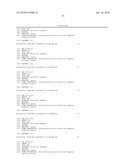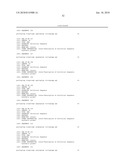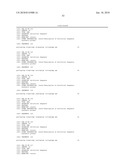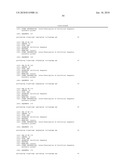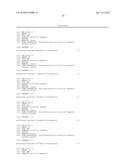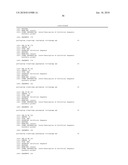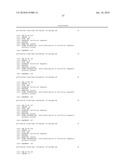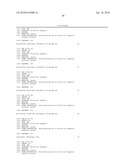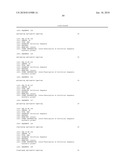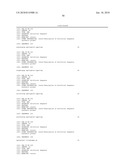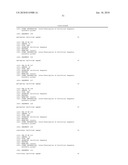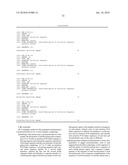Patent application title: MULTITAG SEQUENCING ECOGENOMICS ANALYSIS-US
Inventors:
Patrick M. Gillevet (Oakton, VA, US)
Assignees:
BioSpherex, LLC, A Limited Liability Company
IPC8 Class: AC12Q168FI
USPC Class:
435 6
Class name: Chemistry: molecular biology and microbiology measuring or testing process involving enzymes or micro-organisms; composition or test strip therefore; processes of forming such composition or test strip involving nucleic acid
Publication date: 2010-06-10
Patent application number: 20100143908
Claims:
1-26. (canceled)
27. A multiplex method for the quantitative determination of polynucleotides in two or more samples, comprising:hybridizing a first primer pair to polynucleotides in a first sample, the first primer of said first primer pair comprising, in 5' to 3'order, an emulsion PCR linker sequence, a first tag sequence and a first probe sequences specific for a first target sequence and the second primer of said first primer pair comprising , in 5' to 3' order, an emulsion PCR linker sequence, a second tag sequence and a second probe sequence specific for a second target sequence, wherein the first and the second probe sequences flank and hybridize to opposite strands of a variable genetic region such that one strand of said variable genetic region is the template strand for elongation of each primer, wherein each of said emulsion PCR linker sequences is effective for binding to a solid support and for emulsion PCR amplification, and wherein said emulsion PCR linker sequences of said first and second primers may be the same or different;amplifying primer templates formed thereby to form a first population of tagged polynucleotides, each of said tagged polynucleotides comprising: (a) the sequence of said first primer of said first primer pair, a sequence of said variable genetic region, and a sequence complementary to the sequence of said second primer of said first primer pair or (b) a sequence complementary to the sequence of said first primer of said first primer pair, a sequence of said variable genetic region and the sequence of said second primer of said first primer pair;hybridizing a second primer pair to polynucleotides in a second sample, the first primer of said second primer pair comprising, in 5' to 3' order, an emulsion PCR linker sequence, a third tag sequence and said first probe sequences specific for said first target sequence and the second primer of said second primer pair comprising, in 5' to 3' order, an emulsion PCR linker sequence, a fourth tag sequence and said second probe sequence specific for said second target sequence, wherein each of said emulsion PCR linker sequences is effective for binding to a solid support and for emulsion PCR amplification, and wherein said emulsion PCR linker sequences of said first and second primers may be the same or different; and may be the same or different from those of said first and second primers of said first primer pair;amplifying primer templates formed thereby to from a second population of tagged polynucleotides, each of said tagged polynucleotides comprising: (a) the sequence of said first primer of said second primer pair, a sequence of said variable genetic region, and a sequence, complementary to the sequence of said second primer of said second primer pair or (b) a sequence complementary to the sequence of said first primer of said second primer pair, a sequence of said variable genetic region and the sequence of said second primer of said second primer pair;mixing said first and second populations together;binding individual polynucleotides to a solid support via said linker sequence effective for said binding and amplifying said bound polynucleotides by emulsion PCR, determining sequences of thus amplified polynucleotides comprising the tag sequences and the variable genetic element;from the tag sequences comprised in the polynucleotide sequences thus determined identifying the sample in which polynucleotide sequences occurred;from the sequences of the variable genetic region comprised in the polynucleotide sequences thus determined identifying particular variants of said variable genetic element;from this information determining the number of times given variants occur in each sample, andfrom the number for each variant in the polynucleotides thus determined, quantifying said polynucleotides in said samples.wherein said sequences are determined without Southern blot transfer and/or without size-separating primer extension products and/or without electrophoresis.
28. A method according to claim 27, wherein the number of said polynucleotides in said first sample is any of 5, 10, 25, 50, 100, 150, 200, 250, 500, 1,000, 1,500, 2,000, 2,500, 5,000, 7,500, 10,000, 12,500, 15,000, 17,500, 20,000, 25,000, 30,000, 35,000, 40,000, 50,000, 75,000, 100,000, 150,000, 200,000, 250,000, 500,000, 1,000,000 or more, and the number of said polynucleotides in said second sample is any of 5, 10, 25, 50, 100, 150, 200, 250, 500, 1,000, 1,500, 2,000, 2,500, 5,000, 7,500, 10,000, 12,500, 15,000, 17,500, 20,000, 25,000, 30,000, 35,000, 40,000, 50,000, 75,000, 100,000, 150,000, 200,000, 250,000, 500,000, 1,000,000 or more.
29. A method according to claim 27, wherein the number of said samples and of said different tags therefore is 5, 10, 15, 20, 25, 50, 75, 100, 150, 200, 250, 500, 1,000, 2,500, 5,000, 10,000 or more.
30. A method according to claim 27, wherein the tags are nucleotide sequences that are 4, 5, 6, 7, 8, 9, 10, 11, 12, 13, 14, 15, 16, 17, 18, 19, 20, 21, 22, 23, 24, 25, 26, 27, 28, 29, 30, 31, 32, 33, 34, 35, 36 nucleotides long or any combination thereof.
31. A method according to claim 27, wherein each of said polynucleotides is disposed individually on a bead isolated from other said polynucleotides, is amplified while disposed therein, the amplification products thereof also are disposed on said bead, and each said bead is disposed individually in a well isolated from other said beads.
32. A method according to claim 27, wherein the sequences are determined by pyrosequencing.
32. A method according to claim 27, wherein said samples are biological samples, each comprising one or more species.
33. A method according to claim 27, wherein variants of the variable genetic region are specific to particular organisms.
34. A method according to claim 27, wherein said variable genetic region comprises a variable 16S rRNA sequence, a variable 18S rRNA sequence, a variable rRNA ITS sequence, a mitochondrial sequence, a microsatellite sequence, a metabolic enzyme sequence, and/or a genetic disease sequence.
35. A method according to claim 27, wherein the samples are microbial community samples.
36. A method according to claim 27, wherein the samples are microbial community samples for clinical analysis of a patient.
37. A method according to claim 27, wherein the samples are microbial community environmental samples.
38. A method according to claim 27, wherein the samples are microbial community soil samples.
39. A method according to claim 27, wherein the samples are microbial community water samples.
40. A method according to claim 27, wherein the samples are samples for SNP analysis.
41. A method according to claim 27, wherein the samples are samples for genotyping.
42. A kit comprising a plurality of two or more primers, each primer in said plurality comprising, in 5' to 3' order, an emulsion PCR linker sequence, a tag sequence and a probe sequence specific to a target sequence, wherein:(A) each emulsion PCR linker sequence is effective for binding to a solid support and for emulsion PCR amplification, wherein the emulsion PCT linker sequences may be the same or different in said primers;(B) in each of said primers: the tag sequence is different from the tag sequence of the other primers in the plurality; the tag sequence is not the complementary sequence to any other tag sequence in the plurality; the tag sequence does not contain any homodinucleotide sequences; the junction sequence between the tag sequence and the adjacent parts of the primer, if any, is not a homodinucleotide sequence;(C) in each of said primers the probe sequence is complementary to the target sequence and the target sequence is located 3' to a variable genetic region, and(D) each of said primers is disposed separately from the others in containers in said kit.
43. A kit according to claim 42, wherein said emulsion PCR linker sequence is the same in all of said primers, said kit further comprising a primer complimentary to and effective for polymerization from said emulsion PCR linker sequence.
44. A kit comprising a plurality of two or more primers pairs, each primer in said plurality comprising, in 5' to 3' order, an emulsion PCR linker sequence, a tag sequence and a probe sequence specific to a target sequence, wherein: (A) wherein each emulsion PCR linker sequence is effective for binding to a solid support and for emulsion PCR amplification;(B) in each of said primers: the tag sequence is different from the tag sequence of the other primers in the plurality; the tag sequence is not the complementary sequence to any other tag sequence in the plurality; the tag sequence does not contain any homodinucleotide sequences; the junction sequence between the tag sequence and the adjacent parts of the primer, if any, is not a homodinucleotide sequence;(C) in each of said primers the probe sequence is complementary to the target sequence,(D) in each primer pair the probe sequences are specific to target sequences that flank a variable genetic region.;(E) each of said primer pairs or each of said primers is disposed separately from others in said kit.
45. A kit according to claim 44, wherein the emulsion PCR linker sequence either is the same in all the primers, or one member of each pair has the same first emulsion PCR linker sequence and the second member of each pair has the same second emulsion PCR linker sequence, said kit further comprising disposed separately from one another in one or more containers one or more primers complementary to and effective for elongation from said emulsion PCT linker sequence or sequences.
Description:
RELATED APPLICATIONS
[0001]This application is a continuation in part and claims full benefit of priority of US provisional application number 60/858,948, filed on Nov. 15, 2006 by Patrick Gillevet for Multitag Sequencing and Ecogenomics Analysis, which is incorporated herein by reference in its entirety.
FIELD OF THE INVENTION
[0003]The invention relates to the determination of polynucleotide sequences. It also relates to determining sequences in multiple samples, in some particulars in multiple environmental samples and in multiple clinical samples.
BACKGROUND
[0004]Sequence determination technologies for proteins, RNAs and DNAs, have been pivotal in the development of modern molecular biology. During the past fifteen years, DNA sequencing in particular has been the core technology in an on-going revolution in the scope and the depth of understanding of genomic organization and function. The on-going development of sequencing technology is, perhaps, best symbolized by the determination of the complete sequence of a human genome.
[0005]The human genome sequencing project served a number of purposes. It served as a platform for programmatic development of improved sequencing technologies and of genome sequencing efforts. It also served to provide a framework for the production and distribution of sequencing information from increasingly large scale sequencing projects. These projects provided complete genome sequences for a succession of model organisms of increasingly large genetic complements. These accomplishments, culminating in the completion of a human genome sequence, highlight the very considerable power and throughput of contemporary sequencing technology.
[0006]At the same time, however, they highlight the limitations of current technology and the need for considerable improvements in speed, accuracy, and cost before sequencing can be fully exploited in research and medicine. Among the areas that can be seen most readily to require advances in sequencing technology are clinical sequencing applications that require whole genome information, environmental applications involving multiple organisms in mixtures, and applications that require processing of many samples. These are, of course, just a few among a great many areas that either require or will benefit greatly from more capable and less expensive sequencing methods.
[0007]To date, virtually all sequencing has been done by Sanger chain elongation methods. All Sanger methods require separating the elongation products with single base resolution. Currently, while PAGE still is used for this purpose in some commercial sequencers, capillary electrophoresis is the method of choice for high throughput DNA sequencers. Both gel-based and capillary-based separation methods are time consuming, costly, and limit throughput. Chip based methods, such as Affymetrix GeneChips and HySeq's sequencing by hybridization methods, require chips that can be produced only by capital intensive and complex manufacturing processes. These limitations pose obstacles to the utilization of sequencing for many purposes, such as those described above. Partly to overcome the limitations imposed by the necessity for powerful separation techniques in chain termination sequencing methods and the manufacturing requirements of chip-based methods, a number of technologies are currently being developed that do not require the separation of elongation products with integer resolution and do not require chips.
[0008]A lead technology of this type is a bead, emulsion amplification, and pyrosequencing-based method developed by 454 Life Sciences. (See Marguilles, et al. (2005) Nature 437:376, which is incorporated herein by reference in its entirety, particularly as to the aforementioned methods. The method utilizes a series of steps to deposit single, amplified DNA molecules in individual wells of a plate containing several million picoliter wells. The steps ensure that each well of the plate either contains no DNA or the amplified DNA from a single original molecule. Pyrosequencing is carried out in the wells by elongation of a primer template in much the same way as Sanger sequencing. Pyrosequencing does not involve chain termination and does not require separation of elongation products. Instead sequencing proceeds stepwise by single base addition cycles. In each cycle one of the four bases--A, T, G, or C--is included in the elongation reaction. The other three bases are omitted. A base is added to the growing chain if it is complementary to the next position on the template. Light is produced whenever a base is incorporated into the growing complimentary sequence. By interrogating with each of A, C, G, or T in succession, the identity of the base at each position can be determined. Sequencing reactions are carried out in many wells simultaneously. Signals are collected from all the wells at once using an imaging detector. Thus, a multitude of sequences can be determined at the same time
[0009]In principle, each well containing a DNA will emit a signal for only one of the four bases for each position. In practice, runs of the same base at two or more positions in succession lead to the emission of proportionally stronger signals for the first position in the run. Consequently, reading out the sequence from a given well is a bit more complicated then simply noting, for each position, which of the four bases is added. Nevertheless, because signals are proportional to the number of incorporations, sequences can be accurately reconstructed from the signal strength for most runs.
[0010]The technology has been shown to read accurately an average of about 250 or so bases per well with acceptable accuracy. A device offered by 454 Life Sciences currently uses a 6.4 cm2 picoliter well "plate" containing 1,600,000 picoliter sized wells for sequencing about 400,000 different templates. The throughput for a single run using this plate currently is about 100 million bases in four hours. Even though this is a first generation device, its throughput is nearly 100 times better than standard Sanger sequencing devices.
[0011]Numerous other methods are being developed for ultra high throughput sequencing by other institutions and companies. Sequencing by synthesis methods that rely on target amplification are being developed and/or commercialized by George Church at Harvard University, by Solexa, and by others. Ligation sequencing methods have been developed and/or are being commercialized by Applied Biosystems and Solexa, among others. Array and hybridization sequencing methods are commercially available and/or are being developed by Affymetrix, Hyseq, Biotrove, Nimblegen, Illumina, and others. Methods of sequencing single molecules are being pursued by Helicos based on sequencing by synthesis and U.S. Genomics (among others) based on poration.
[0012]These methods represent a considerable improvement in throughput over past methods, in some regards. And they promise considerable improvement in economy as well. However, currently they are expensive to implement and use, they are limited to relatively short reads and, although massively parallel, they have limitations that must be overcome to realize their full potential.
[0013]One particular disadvantage of these methods, for example, is that samples must be processed serially, reducing throughput and increasing cost. This is a particularly great disadvantage when large numbers of samples are being processed, such as may be the case in clinical studies and environmental sampling, to name just two applications. The incorporation of indexing sequences by ligation to random shotgun libraries has been disclosed in U.S. Pat. Nos.: 7,264,929, 7,244,559, and 7,211,390, but the direct ligation methods therein disclosed distort the distribution of the components within the samples (as illustrated in FIG. 4 herein) and therefore are inappropriate for enumerating components within each sample.
[0014]Accordingly, there is a need to improve sample throughput, to lower the costs of sequencing polynucleotides from many samples at a time, and to accurately enumerate the components of samples analyzed by high throughput, parallelized and multiplex techniques.
SUMMARY
[0015]It is therefore an object of the present invention to provide sequencing methods with improved sample throughput. The following paragraphs describe a few illustrative embodiments of the invention that exemplify some of its aspects and features. They are not exhaustive in illustrating its many aspects and embodiments, and thus are not in any way limitative of the invention. Many other aspects, features, and embodiments of the invention are described herein. Many other aspects and embodiments will be readily apparent to those skilled in the art upon reading the application and giving it due consideration in the full light of the prior art and knowledge in the field.
[0016]Embodiments provide multiplex methods for the quantitative determination of polynucleotides in two or more samples, comprising:
[0017]hybridizing a first primer to polynucleotides in a first sample, said first primer comprising a first tag sequence and a first probe sequence specific for a first target sequence, wherein said first target sequence is 3' to a variable genetic region;
[0018]elongating primer templates formed thereby to form a first population of tagged polynucleotides comprising: said first primer including said first tag sequence; and sequences of said variable genetic region;
[0019]hybridizing a second primer to polynucleotides in a second sample, said second primer comprising a second tag sequence and a second probe sequence specific for a second target sequence, wherein said second target sequence is 3' to the same variable genetic region as said first target sequence, wherein further said second probe sequence may be the same as or different from said first probe sequence;
[0020]elongating primer templates formed thereby to form a second population of tagged polynucleotides comprising: said second primer including said second tag sequence; and sequences of said variable genetic region;
[0021]mixing said first and second populations together;
[0022]determining sequences of polynucleotides comprising tag sequences and the sequences of the variable genetic element in said mixture;
[0023]from the tag sequences comprised in the polynucleotide sequences thus determined identifying the sample in which polynucleotide sequences occurred;
[0024]from the sequences of the variable genetic region comprised in the polynucleotide sequences thus determined identifying particular variants of said variable genetic element;
[0025]from this information determining the number of time one or more given variants occur in each sample, and
[0026]from the number for each variant in the polynucleotides thus determined, quantifying said polynucleotides in said samples;
[0027]wherein said sequences are determined without Southern blot transfer and/or without size-separating primer extension products and/or without electrophoresis.
[0028]Embodiments provide multiplex methods for the quantitative determination of polynucleotides in two or more samples, comprising:
[0029]hybridizing a first primer pair to polynucleotides in a first sample, the first primer of said first primer pair comprising a first tag sequence and a first probe sequences specific for a first target sequence and the second primer of said first primer pair comprising a second tag sequence and a second probe sequence specific for a second target sequence, wherein the first and the second probe sequences flank and hybridize to opposite strands of a variable genetic region;
[0030]elongating primer templates formed thereby to from a first population of tagged polynucleotides, each of said polynucleotides comprising: (a) the sequence of said first primer of said first primer pair, a sequence of said variable genetic region, and a sequence complementary to the sequence of said second primer of said first primer pair or (b) a sequence complementary to the sequence of said first primer of said first primer pair, a sequence of said variable genetic region and the sequence of said second primer of said first primer pair;
[0031]hybridizing a second primer pair to polynucleotides in a second sample, the first primer of said second primer pair comprising a third tag sequence and said first probe sequences specific for said first target sequence and the second primer of said second primer pair comprising a fourth tag sequence and said second probe sequence specific for said second target sequence;
[0032]elongating primer templates formed thereby to from a second population of tagged polynucleotides, each of said polynucleotides comprising: (a) the sequence of said first primer of said second primer pair, a sequence of said variable genetic region, and a sequence complementary to the sequence of said second primer of said second primer pair or (b) a sequence complementary to the sequence of said first primer of said second primer pair, a sequence of said variable genetic region and the sequence of said second primer of said second primer pair;
[0033]mixing said first and second populations together;
[0034]determining sequences of polynucleotides in said mixture, comprising the tag sequences and the variable genetic element;
[0035]from the tag sequences comprised in the polynucleotide sequences thus determined identifying the sample in which polynucleotide sequences occurred;
[0036]from the sequences of the variable genetic region comprised in the polynucleotide sequences thus determined identifying particular variants of said variable genetic element;
[0037]from this information determining the number of times given variants occur in each sample, and
[0038]from the number for each variant in the polynucleotides thus determined, quantifying said polynucleotides in said samples.
[0039]wherein said sequences are determined without Southern blot transfer and/or without size-separating primer extension products and/or without electrophoresis.
[0040]Embodiments provide methods in accordance with any of the foregoing or the following wherein given polynucleotide sequences in a sample is quantified by a method comprising normalizing the number occurrences determined for the given sequence. In embodiments the number of occurrences is normalized by dividing the number of occurrences determined for the given polynucleotide sequence by the total number of occurrences of polynucleotide sequences in the sample. In embodiments the given polynucleotide sequences is that of a given variant of a variable genetic region and, in embodiments, the quantity of the given variant in the sample is normalized by dividing the number of occurrences of that variant by the total number of occurrences of all variants of the variable genetic region in the sample.
[0041]Embodiments provide a multiplex method for determining polynucleotide sequences in two or more samples, comprising: attaching a first tag sequence to one or more polynucleotides of a first sample; attaching a second tag sequence different from said first tag sequence to one or more polynucleotides of a second sample; mixing the tagged polynucleotides of said first and second samples together; determining sequences of said polynucleotides comprising said first and said second tags; and identifying said first and second tags in said sequences; thereby identifying sequences of said polynucleotides of said first sample and second samples, wherein said sequences are determined without Southern blot transfer and/or without size-separating primer extension products and/or without electrophoresis.
[0042]Embodiments provide a multiplex method for determining polynucleotide sequences in two or more samples comprising: attaching a first tag sequence, t1, to P1-1 through P1-n1 polynucleotides in a first sample, thereby to provide a first plurality of polynucleotides tagged with said first tag, t1P1-1 through t1P1-n1;
[0043]attaching a second tag sequence, t2, to P2-1 through P2-n2 polynucleotides in a second sample, thereby to provide a second plurality of polynucleotides tagged with said second tag, t2P2-1 through t2P2-n2;
[0044]mixing together said polynucleotides tagged with said first and said second tags;
[0045]determining sequences of polynucleotides comprising said tags in said mixture;
[0046]identifying said first and second tags in said sequences and;
[0047]by said first tag identifying polynucleotide sequences of said first sample and by said second tag identifying polynucleotide sequences of said second sample;
[0048]wherein said sequences are determined without Southern blot transfer and/or without size-separating primer extension products and/or without electrophoresis.
[0049]Embodiments provide a method according to any of the foregoing or the following, wherein the number of said polynucleotides in said first sample, n1, is any of 2, 5, 10, 25, 50, 100, 150, 200, 250, 500, 1,000, 1,500, 2,000, 2,500, 5,000, 7,500, 10,000, 12,500, 15,000, 17,500, 20,000, 25,000, 30,000, 35,000, 40,000, 50,000, 75,000, 100,000, 150,000, 200,000, 250,000, 500,000, 1,000,000 or more, and the number of said polynucleotides in said second sample, n2, is any of 2, 5, 10, 25, 50, 100, 150, 200, 250, 500, 1,000, 1,500, 2,000, 2,500, 5,000, 7,500, 10,000, 12,500, 15,000, 17,500, 20,000, 25,000, 30,000, 35,000, 40,000, 50,000, 75,000, 100,000, 150,000, 200,000, 250,000, 500,000, 1,000,000 or more.
[0050]Embodiments provide a method according to any of the foregoing or the following, wherein the number of said samples and of said different tags therefor is 5, 10, 15, 20, 25, 50, 75, 100, 150, 200, 250, 500, 1,000, 2,500, 5,000, 10,000 or more.
[0051]Embodiments provide a method according to any of the foregoing or the following, wherein the tags are nucleotide sequences that are 2, 3, 4, 5, 6, 7, 8, 9, 10, 11, 12, 13, 14, 15, 16, 17, 18, 19, 20, 21, 22, 23, 24, 25, 26, 27, 28, 29, 30, 31, 32, 33, 34, 35, 36 nucleotides long or any combination thereof.
[0052]Embodiments provide a method according to any of the foregoing or the following, wherein the tags are incorporated into said polynucleotides by a step of ligation, provided that the step of ligation does not result in biasing.
[0053]Embodiments provide a method according to any of the foregoing or the following, wherein the tags are incorporated into said polynucleotides by a step of ligation and/or by a step of amplification.
[0054]Embodiments provide a method according to any of the foregoing or the following, wherein said tags are comprised in primers for amplification and are incorporated into said polynucleotides by amplification using said primers.
[0055]Embodiments provide a method according to any of the foregoing or the following, wherein said tags are incorporated into said polynucleotides by a process comprising a step of cloning into a vector.
[0056]Embodiments provide a method according to any of the foregoing or the following, wherein the tags are comprised in adapters for amplification and said adapters are ligated to polynucleotides in said samples. Embodiments provide a method in this regard, wherein further, said polynucleotides ligated thereby to said tags are amplified via said adapters.
[0057]Embodiments provide a method in this regard, wherein further, said adapters comprise a moiety for immobilization. In embodiments said moiety is a ligand; in embodiments it is biotin. Embodiments provide a method in this regard, wherein further, said tags are comprised on adapters for bead emulsion amplification. In embodiments the adapters are suitable for use in a sequencing system of 454 Life Sciences or other sequencing system in which bead emulsion amplification is carried out.
[0058]Embodiments provide a method according to any of the foregoing or the following, wherein the primer for amplification comprises a sequence for PCR amplification, linear amplification, transcriptional amplification, rolling circle replication, or QB replication.
[0059]Embodiments provide a method according to any of the foregoing or the following, wherein the primer for amplification comprises a sequence for PCR amplification.
[0060]Embodiments provide a method according to any of the foregoing or the following, wherein each of said polynucleotides is disposed individually on a bead isolated from other polynucleotides.
[0061]Embodiments provide a method according to any of the foregoing or the following, wherein each of said polynucleotides is disposed individually on a bead isolated from other said polynucleotides, is amplified while disposed therein, and the amplification products thereof also are disposed on said bead.
[0062]Embodiments provide a method according to any of the foregoing or the following, wherein each of said polynucleotides is disposed individually on a bead isolated from other said polynucleotides, is amplified while disposed therein, the amplification products thereof also are disposed on said bead, and each said bead is disposed individually in a well isolated from other said beads.
[0063]Embodiments provide a method according to any of the foregoing or the following, wherein the sequences are determined by pyrosequencing.
[0064]Embodiments provide a method according to any of the foregoing or the following, wherein said samples are biological samples, each comprising one or more species.
[0065]Embodiments provide a method according to any of the foregoing or the following, wherein at least one sequence of said polynucleotides is specific to a particular organism.
[0066]Embodiments provide a method according to any of the foregoing or the following, wherein said sequences comprise a variable 16S rRNA sequence.
[0067]Embodiments provide a method according to any of the foregoing or the following, wherein said sequences comprise a variable 18S rRNA sequence, a variable rRNA ITS sequence, a mitochondrial sequence, a microsatellite sequence, a metabolic enzyme sequence, and/or a genetic disease sequence.
[0068]Embodiments provide a method according to any of the foregoing or the following, wherein the samples are microbial community samples.
[0069]Embodiments provide a method according to any of the foregoing or the following, wherein the samples are microbial community samples for clinical analysis of a patient.
[0070]Embodiments provide a method according to any of the foregoing or the following, wherein the samples are microbial community environmental samples.
[0071]Embodiments provide a method according to any of the foregoing or the following, wherein the samples are microbial community soil samples. Embodiments provide a method according to any of the foregoing or the following, wherein the samples are microbial community water samples.
[0072]Embodiments provide a method according to any of the foregoing or the following, wherein the samples are samples for SNP analysis.
[0073]Embodiments provide a method according to any of the foregoing or the following, wherein the samples are samples for genotyping.
[0074]Embodiments provide a multiplex method according to any of the foregoing or the following for determining polynucleotide sequences of two or more samples, comprising,
[0075]amplifying polynucleotides of a first sample to produce first amplified polynucleotides comprising a first tag sequence;
[0076]separately amplifying polynucleotides of a second sample to produce second amplified polynucleotides comprising a second tag sequence different from said first tag sequence;
[0077]wherein the amplification products arising from different individual polynucleotides are spatially separated from one another;
[0078]mixing together amplicons of said first and second samples;
[0079]distributing the amplicons in the mixture into spatially distinct locations; sequencing the amplicons thus distributed using one or more primers that hybridize 5' to said tag sequences;
[0080]identifying said tag sequences in the sequences of polynucleotides thus determined; and
[0081]identifying by said tags polynucleotides of said first sample and polynucleotides of said second sample.
[0082]Embodiments provide a method according to any of the foregoing or the following, comprising,
[0083](a) for each sample separately: isolating polynucleotides to be sequenced, ligating said polynucleotides to a common adaptor comprising a tag sequence, and capturing individual ligated polynucleotides onto individual beads under conditions that provide predominately for the immobilization of 0 or 1 molecule per bead;
[0084](b) thereafter mixing together said beads comprising said polynucleotides.
[0085]Embodiments provide a method according to any of the foregoing or the following, further comprising, amplifying bead-immobilized polynucleotides in droplets of an emulsion thereby to clonally amplify said individual polynucleotides on said beads, wherein amplification comprises amplification of said tag sequence.
[0086]Embodiments provide a method according to any of the foregoing or the following, further comprising, distributing individual droplets containing said amplified polynucleotides into wells under conditions that provide predominantly for 0 or 1 droplet per well, determining in individual wells the sequences of polynucleotides comprising said tag sequences, and by said tag sequences identifying polynucleotides of said first and said second samples.
[0087]In embodiments the invention provides methods in accordance with any of the foregoing or the following, for any one or more of detecting, monitoring, profiling, prognosticating, and/or diagnosing a disorder, disease, or the like.
[0088]In embodiments the invention provides methods in accordance with any of the foregoing or the following, for analyzing the composition, diversity, stability, dynamics, and/or changes in agricultural, food, biosecurity, veterinary, clinical, ecological, zoological, oceanological, and/or any other sample comprising one or more polynucleotides.
[0089]Embodiments provide kits comprising a plurality of two or more primers, each primer in said plurality comprising a tag sequence and a probe sequence specific to a target sequence, wherein:
[0090](A) in each of said primers the probe sequence is 3' to the tag sequence, but not necessarily adjacent thereto;
[0091](B) in each of said primers: the tag sequence is different from the tag sequence of the other in the plurality; the tag sequence is not the complementary sequence to any other tag sequence in the plurality; the tag sequence does not contain any homodinucleotide sequences; the junction sequences between the tag sequence and the adjacent parts of the primer, if any, is not a homodinucleotide sequence;
[0092](C) in each of said primers the probe sequence is complementary to the target sequence and the target sequence is located 3' to a variable genetic region, and
[0093](D) each of said primers is disposed separately from the others in containers in said kit.
[0094]Embodiments provide kits in accordance with any of the foregoing or the following, wherein each of said primers further comprises a priming sequence 5' to the tag sequence but not necessarily adjacent thereto, and the priming sequence is the same in all of said primers, said kit further comprising a primer complimentary to and effective for polymerization from said priming sequence.
[0095]Embodiments provides kits comprising a plurality of two or more primers pairs, each primer in said plurality comprising a tag sequence and a probe sequence specific to a target sequence, wherein:
[0096](A) in each of said primer the probe sequence is 3' to the tag sequence, but not necessarily adjacent thereto;
[0097](B) in each of said primers: the tag sequence is different from the tag sequence of the other in the plurality; the tag sequence is not the complementary sequence to any other tag sequence in the plurality; the tag sequence does not contain any homodinucleotide sequences; the junction sequences between the tag sequence and the adjacent parts of the primer, if any, is not a homodinucleotide sequence;
[0098](C) in each of said primers the probe sequence is complementary to the target sequence,
[0099](D) in each primer pair the probe sequences are specific to target sequences that flank a variable genetic region;
[0100](E) each of said primers is disposed separately from the others in said kit.
[0101]Embodiments provides kits in accordance with any of the foregoing or the following, wherein, the primers further comprise a priming sequence 5' to the tag sequence but not necessarily adjacent thereto, the priming sequence either is the same in all the primers, or one member of each pair has the same first priming sequence and the second member of each pair has the same second priming sequence, said kit further comprising disposed separately from one another in one or more containers one or more primers complementary to and effective for elongation from said priming
[0102]Embodiments provide a kit useful in methods according to any of the foregoing or the following, comprising a set of primers and/or adapters, wherein each primer and/or adapter in said set comprises a tag sequence and a primer sequence. In embodiments the primers and/or adapters further comprise a moiety for immobilization. In embodiments the primers and/or adapters comprise biotin. In embodiments the primers and/or adapters in the set comprise all tag sequences defined by 2, 3, 4, 5, 6, 7, or 8 base polynucleotide sequences, wherein each of said primers and/or adapters are disposed in containers separate from one another. In embodiments there are 1-5, 3-10, 5-15, 10-25, 20-50, 25-75, 50-100, 50-150, 100-200, 150-500, 250-750, 100-1000, or more different tag sequences disposed separately from one another, so as to be useful for uniquely tagging said number of different samples. In embodiments the primers and/or adapters are suitable for use as 454 Life Sciences amplification adapters and/or primers. In embodiments the primers and/or adapters further comprise any one or more of a primer sequence for any one or more of a 16S rRNA sequence, an 18S rRNA sequence, an ITS sequence, a mitochondrial sequence, a microsatellite sequence, a metabolic enzyme sequence, a genetic disease sequence, and/or any other sequence for amplification or analysis.
[0103]In embodiments the invention provides a kit, in accordance with any of the foregoing or the following, comprising a set of primers and/or adapters for use in a method according to any of the foregoing or the following, wherein each primer and/or adapter in said set comprises a tag sequence, the tag sequence of each of said primers and/or adapters is different from that of the other primers and/or adapters in said set, the primers and/or adapters further comprise a priming sequence that is the same in all of the primers and/or adapters in said set, the tag sequences are located 5' to the priming sequence and the different primers and/or adapters comprising each different tag sequence are disposed separately from one another. In embodiments the tags are any number of bases long. In embodiments the tags are 2, 3, 4, 5, 6, 8, 10, 12 bases long. In embodiments the tags are 4 bases long. In embodiments the priming sequence is specific to any target polynucleotide of interest. In embodiments the priming sequence is specific to a sequence in 16S rRNA. In embodiments the tags differ from each other by at least 2 bases. In embodiments the tags do not contain polynucleotide tracts within the tag. In embodiments the tags do not contain homo-polynucleotide tracts within or at the junction of the tag and PCR primer. In embodiments the tags do not contain polynucleotide tracts within or at the junction of the tag and emulsion PCR adapter. In embodiments, the tags are not reverse compliments of each other.
BRIEF DESCRIPTION OF THE FIGURES
[0104]FIG. 1 is a schematic diagram showing a general embodiment of the invention. A plurality of samples (S1, S2, through Sj) is shown topmost in the Figure. Each sample is comprised of a plurality of polynucleotides (P1-1 to P1-n1 in S1; P2-1 to P2-n2 in S2; through Pj-1 to Pj-nj). The polynucleotides in each sample are labeled separately with a tag polynucleotide sequence, all the polynucleotides in a given sample being tagged (in this illustration) with a single tag sequence, designated in the figure as T1 for S1, T2 for S2, through Tj for Sj. The individual tagged polynucleotides are denoted accordingly. The tagged polynucleotides in each sample are designated collectively, for each sample, T1S1, T2S2, through TjSj. The tagged polynucleotides from the samples are mixed together to form a mixture, designated Mi. The mixture is sequenced, typically by a massively parallel sequencing method. The tag sequences are identified in the data thus obtained. The sequences are grouped by tag. The sequences from the individual samples are thereby identified.
[0105]FIG. 2A is a diagram depicting step I in the multitag sequencing of microbial community samples using a tagged 16S forward and reverse primer-linker pairs for PCR amplification. (a) represents the Forward 16S rRNA primer with Tag I and Emulsion PCR Linker, (b) represents the 16S rRNA sequence, (c) represents the Reverse 16S rRNA primer with Tag j and Emulsion PCR Linker, (d) represents the Amplified 16S rRNA sequence with Forward and Reverse Tags ij, (e) represents the Emulsion PCR Bead, (f) represents the pyrosequencing read, (g) represents the well in picoliter plate, (h) represents a Unique tag, (i) represents Amplified Community 1, (j) represents Amplified Community 2, and (k) represents Amplified Community n. Step 1 involves the amplification of the microbial community from each sample using uniquely tagged universal primers-linkers. In step 1, different samples are amplified separately, using 16S rRNA specific adapter-tag-primers with a different tag for each sample.
[0106]FIG. 2B is a diagram depicting the Emulsion PCR reaction beads randomly arrayed into picoliter plate. In step 2 in the process, the PCR products from all the samples are mixed, immobilized on beads, distributed into wells of the picoliter plate, and emulsion PCR amplified.
[0107]FIG. 2C is a diagram depicting the pyrosequencing process from each outside adapter in each well of the picoliter plate. Each reaction reads sequence from the adapter, through the unique tags and the associated sequence of the tagged sample
[0108]FIG. 2D is a diagram depicting the algorithmic sorting of the Pyrosequencing reads using the individual tag sequence and a portion of the primer sequence. (1) represents the sequence reads from sample 1, (m) represents the sequence reads from sample 2, and (n) represents the sequence reads from sample n.
[0109]FIG. 2E is a diagram depicting the identification of microbial taxa by comparing the sequence reads for each sample against the 16S rRNA sequence database and then normalize abundance in each taxa with respect to the total reads in that particular sample. (o) represents the normalized species histogram derived the pyrosequencing reads obtained from sample 1, (p) represents the normalized species histogram derived the pyrosequencing reads obtained from sample 2, (q) represents the normalized species histogram derived the pyrosequencing reads obtained from sample n,
[0110]FIG. 3 is the species distribution in (A) Controls, (B) Crohns, and (C) Ulcerative colitis samples determined by the 454 Life Science pyrosequencing process. Each bar in the histogram is the average normalized abundance of that taxa in each disease state. Each sample was run in a separate well on the picoliter plate using the 454 16 well mask.
[0111]FIG. 4 is an example of the distortion of the components of a complex mixture caused by ligating the Emulsion PCR adapters onto PCR amplicons. FIG. 4A shows the size distribution of PCR amplicons in sample 309 before ligation and FIG. 4B shows the size distribution of sample 309 after ligation.
[0112]FIG. 5 is an example of the normalized taxa abundances in duplicate samples determined by Multitag pyrosequencing after direct ligation of the emulsion PCR adapters.
[0113]FIG. 6 shows all possible hexameric polynucleotide tags within which there are no dinucleotide repeats and no tag is the reverse complement of any other tag.
[0114]FIG. 7 shows 96 tagged adaptor primers in which there are no dinucleotide repeats in the tags, no dinucleotide repeats at the junction of the tags and the tags are not reverse complements of one another. In each case 5 bases of the primer also can be used to identify samples. 7A and 7B show the forward primers (SEQ ID NOS 1-96, respectively in order of appearance). 7C and 7D show the reverse primers (SEQ ID NOS 97-192, respectively in order of appearance).
GLOSSARY
[0115]The meanings ascribed to various terms and phrases as used herein are illustratively explained below.
[0116]"A" or "an" means one or more; at least one.
[0117]"About" as used herein means roughly, approximately. Should a precise numerical definition be required, "about" means +/- 25%.
[0118]"Adapter" means a polynucleotide sequence used to either attach single polynucleotide fragments to beads and/or to prime the emulsion PCR reaction and/or as a template to prime pyrosequencing reactions.
[0119]"ALH" is used herein to mean amplicon length heterogeneity.
[0120]"Amplicon" is used herein to refer to the products of an amplification reaction.
[0121]"Clonally amplified" is used herein generally to mean amplification of a single starting molecule. Typically it also refers to the clustering together of the amplification products, isolated from other amplification templates or products.
[0122]"dsDNA" means double stranded DNA.
[0123]Dysbiosis means a shift in a the species and abundance of species in a microbial community.
[0124]"Flanking" generally is used to mean on each side, such as on the 5' and the 3' side of a region of a polynucleotide--with reference to the 5' and the 3' ends of one or the other stand of a double stranded polynucleotide. Forward and reverse primers for amplifying a region of a polynucleotide by PCR, for instance, flank the region to be amplified.
[0125]"Microbial community sample" is used herein to refer to a sample, generally of a biological nature, containing two or more different microbes. Microbial community samples include, for instance, environmental samples, as well as biological samples, such as samples for clinical analysis. The term applies as well to preparations, such as DNA preparations, derived from such samples.
[0126]"Multiplex sequencing" herein refers to sequencing two or more types or samples of polynucleotides in a single reaction or in a single reaction vessel.
[0127]"PCO" means principal coordinates analysis.
[0128]"PCA" means principal component analysis.
[0129]"Picotiter plate" means a plate having a large number of wells that hold a relatively small volume, typically more wells than a 96-well microtiter plate, and smaller volumes than those of a typical 96-well microtiter plate well.
[0130]"Primer" means a polynucleotide sequence that is used to amplify PCR products and/or to prime sequencing reactions.
[0131]"ssDNA" means single stranded DNA.
[0132]"Tag," "Tag sequence," etc. means typically a heterologous sequence, such as a polynucleotide sequence that identifies another sequence with which it is associated as being of a given type or belonging to a given group.
[0133]"Variable genetic region" as used herein means a genetic region that varies, such as between individuals of a species and between species. The phrase does not denote a specific length, but, rather is used to denote a region comprising a variation the exact length of which may vary and may differ in different contexts. As to a double stranded polynucleotide. the term includes one or the other and both stands of the region, and may be used to refer to one, the other, or to both strands, and it will generally be clear from the context which is meant. A specific example of a genetic region that varies between individuals, provided for illustration only, is a genetic region that contains an SNP (single nucleotide polymorphism) site. By variable genetic region in this regard is meant a region containing the SNP site. Different sequences of the SNP in this regard constitute the variants of the variable genetic region. A specific example of a variable genetic region that differs between species is the genes for 16S RNA which vary characteristically between microbes and can be used to identify microbes in mixed community samples as described in greater detail in some of the examples herein.
DESCRIPTION OF THE INVENTION
[0134]In certain aspects and embodiments the invention relates to multiplex sequencing analysis using tags. In various aspects and embodiments of the invention in this regard the invention provides methods for sequencing two or more samples simultaneously in a mixture with one another, wherein each sample is first linked to a sample-specific sequence tag, the tagged samples are mixed and sequenced, and the sequences from each sample then are identified by their respective sample-specific sequence tags.
[0135]FIG. 1 provides a general depiction of various aspects and embodiments of the invention in this regard, and the figure is discussed by way of illustration below with reference to sequencing DNA from different samples. A plurality of samples (S1, S2, through Sj) is shown topmost in the Figure. Each sample is comprised of a plurality of polynucleotides (P1-1 to P1-n1 in S1; P2-1 to P2-n2 in S2; through Pj-1 to Pj-nj). The polynucleotides in each sample are labeled separately with a tag polynucleotide sequence, all the polynucleotides in a given sample being tagged (in this illustration) with a single tag sequence, designated in the figure as T1 for S1, T2 for S2, through Tj for Sj. The individual tagged polynucleotides are denoted accordingly. The tagged polynucleotides in each sample are designated collectively, for each sample, T1S1, T2S2 through TjSj. The tagged polynucleotides from the samples are mixed together to form a mixture, designated Mi. The mixture is sequenced typically by a parallel sequencing method. The tag sequences are identified in the data thus obtained. The sequences are grouped by tag. The sequences from the individual samples are thereby identified.
[0136]In embodiments tags are 3 to 30, 4 to 25, 4 to 20 base long sequences. In embodiments the tags are 2, 3, 4, 5, 6, 7, 8, 9, 10, 11, 12, 13, 14, 15, 16, 17, 18, 19, 20, 21, 22, 23, 24, 25, 26, 27, 28, 29, 30, 31, 32, 33, 34, 35, 36 nucleotides long or any combination thereof.
[0137]In embodiments there are 1-6, 6-12, 10-15, 10-20, 15-25, 20-40, 25-50, 25-75, 50-100, 50-150, 100-200, 100-250, 50-250, 100-500, 500-1,000, 100-1,000, 500-5,000, 100-10,000, 1,000-25,000, 500-50,000, 100-100,000, 1-1,000,000 or more samples, tagged, respectively, with 1-6, 6-12, 10-15, 10-20, 15-25, 20-40, 25-50, 25-75, 50-100, 50-150, 100-200, 100-250, 50-250, 100-500, 500-1,000, 100-1,000, 500-5,000, 100-10,000, 1,000-25,000, 500-50,000, 100-100,000, 1-1,000,000 or more different tags.
[0138]In embodiments the sequences are determined without the use of gel electrophoresis.
[0139]In embodiments the sequences are determined without the use of transfer of sequences from a gel onto a membrane or a filter for hybridization. In embodiments, sequences are determined by a parallel sequencing method. In embodiments the sequences are determined by pyrosequencing, sequencing by synthesis, hybridization sequencing, subtractive sequencing, pore sequencing or direct read sequencing.
[0140]In embodiments the tags are incorporated into polynucleotides in samples for sequencing by a step of ligation and/or by a step of amplification.
[0141]In embodiments the tags are comprised in primers for amplification.
[0142]In embodiments the tags are comprised in primers for PCR amplification, transcription amplification, rolling circle amplification, or amplification by Qβ replicase.
[0143]In embodiments the tags are comprised in emulsion PCR adapters and primers for amplification.
[0144]In embodiments the tags are incorporated by a step of cloning into a vector.
[0145]In embodiments the samples are microbial community samples. In embodiments the samples are clinical samples. In embodiments the samples are environmental samples. In embodiments the samples are samples for SNP analysis. In embodiments the samples are samples for genotyping. In embodiments the sequences are determined in one or more picotiter plates.
[0146]In embodiments the samples are fragmented genomic DNAs. In embodiments the samples are fragmented Bacterial genomic DNA, Archae genomic DNA, Fungal genomic
[0147]DNA, Eukaryotic genomic DNA, chloroplast DNA, and/or mitochondrial DNA. In embodiments the samples are cDNAs. In embodiments the samples are Eukaryotic cDNA,
[0148]Bacterial cDNA, Archae cDNA, and/or Fungal cDNA. In embodiments the tags are incorporated by a step of ligation and/or by a step of amplification.
[0149]In embodiments the samples are for any one or more of detecting, monitoring, profiling, prognosticating, and/or diagnosing a disorder, disease, or the like. In embodiments the samples are for analyzing the composition, diversity, stability, dynamics, and/or changes in agricultural, food, biosecurity, veterinary, clinical, ecological, zoological, oceanological, and/or any other sample comprising one or more polynucleotides.
[0150]In embodiments the sequences are determined in wells of a titer plate. In embodiments the sequences are determined in one or more picotiter plates having a mask. In embodiments the sequences are determined in one more picotiter plates having a mask, wherein the mask defines 2, 4, 8, 16, 32, 64 or more compartments.
[0151]By way of illustration to a 454 picotiter plate, in embodiments there are about 120,000 templates/plate and the read length averages about 250 bases per template. In embodiments relating thereto there are 10 tags of 4 bases per 1/16 plate, 160 tags total, an average of about 750 templates per tag (and per sample), and about 187,500 bases sequenced per tag (and per sample).
[0152]In embodiments there are about 260,000 templates/plate and the read length averages about 250 bases per template. In embodiments relating thereto, there are 12 tags of 4 bases per 1/8 plate, 96 samples total, an average of about 2,708 templates per tag (and per sample) and about 677,083 bases of sequence per tag (and per sample).
[0153]In embodiments there are about 400,000 templates/plate and the read length averages about 250 bases per template. In embodiments relating thereto, there are 96 tags of 6 bases for 96 samples per plate, about 4,166 templates per tag (and per sample) and about 1,041,666 bases of sequence per tag (and per sample).
[0154]In embodiments the tags are 10 base long sequences, there are 192 different tags, and the samples are analyzed in microtiter plate format.
[0155]In embodiments the invention provides algorithms for deconvolving, from a mixture of sequences from two or more samples, the sequences of the samples in the mixture by identifying sample-specific tags in the sequences, grouping the sequences by the tags thus identified, thereby grouping together the sequence from each of said samples, apart from one another.
[0156]In embodiments the invention provides algorithms for deconvolving, from a mixture of sequences from two or more samples, the sequences of the samples in the mixture by identifying sample-specific tags in sequences, as follows:
[0157]1. Read all sequence reads into an array;
[0158]2. Search the beginning of each sequence read and identify the tag;
[0159]3. Build an associative array linking tag with sequence read;
[0160]4. Sort the keys for the associate array;
[0161]5. Associate each key with the corresponding sample;
[0162]6. Pool all sequence reads for each sample;
[0163]7. Analyze each sample separately.
[0164]8. Normalize the abundance of each component within each samples with respect to the total reads within that sample.
[0165]In embodiments the algorithm can be implemented in any programming language. In embodiments the algorithm is implemented in C, C++, JAVA, Fortran, or Basic. In embodiments the algorithm is implemented as a PERL script.
[0166]In embodiments the invention provides kits for multiplex sequencing as described herein, comprising a set of primers and/or adapters, wherein each primer and/or adapter in said set comprises a tag sequence, a primer sequence and/or an emulsion PCR adapter. In embodiments the primers and/or adapters further comprise a moiety for immobilization. In embodiments the primers and/or adapters comprise biotin. In embodiments the primers and/or adapters in the set comprise all tag sequences defined by 2, 3, 4, 5, 6, 7, or 8 base polynucleotide sequences, wherein said primers and/or adapters comprising different tag sequences are disposed in containers separate from one another. In embodiments there are 1-5, 3-10, 5-15, 10-25, 20-50, 25-75, 50-100, 50-150, 100-200, 150-500, 250-750, 100-1000, or more different tag sequences disposed separately from one another, so as to be useful for uniquely tagging said number of different samples. In embodiments the primers and/or adapters are suitable for use as 454 Life Sciences amplification adapters and/or primers. In embodiments the primers and/or adapters further comprise any one or more of a primer sequence for any one or more of a 16S rRNA sequence, an 18S rRNA sequence, an ITS sequence, a mitochondrial sequence, a microsatellite sequence, a metabolic enzyme sequence, a genetic disease sequence, and/or any other sequence for amplification or analysis.
EXAMPLES
[0167]The present invention is additionally described by way of the following illustrative, non-limiting examples.
Example 1
Sequencing Using the 454 Pyrosequencing System
[0168]454 Life Sciences, a subsidiary of Roche Diagnostics, provides a device for pyrosequencing approximately 100,000,000 bases of about 400,000 different templates in a single run on a single picotiter plate. The company also provides masks that allows for the processing 2, 4, 8, or 16 different samples on one plate. At maximum capacity using the masked plate, the system provides about 1 million bases of sequence data on about 4,000 templates for each of 16 samples.
[0169]The general process of sequencing using the 454 system is generally as follows: isolate DNA; optionally fragment the DNA; optionally render the DNA double stranded; ligate the DNA to adaptors; separate the strands of the dsDNA, bind the ssDNA to beads under conditions that result in a preponderance of beads that have either no DNA molecule bound to them or a single molecule of DNA bound to them; capture the beads in individual droplets of an emulsion of a PCR reaction mix in oil; carry out a PCR reaction on the emulsion-encapsulated bead-DNAs (whereby amplification products are captured on the beads); distribute the amplification products into picoliter wells so that there is either no bead in a well or one bead; and carry out pyrosequencing on all the beads in all the wells in parallel.
Example 2
Multiplex Pyrosequencing Using 96 Tagged Adapter-PCR Primers
[0170]454 Life Sciences, a subsidiary of Roche Diagnostics, provides a device for pyrosequencing approximately 100,000,000 bases of sequence for about 400,000 different templates in a single run on a single picotiter plate. At maximum capacity using the plate, the system provides about 10 million bases of sequence data for each of about 4,000 templates for each of 96 multitagged samples. In this example the 96 tags are 6 bases in length and are used along with 6 bases of the forward or reverse primer to identify the reads that belong with each of the 96 individual samples (see FIG. 2).
Example 3
Multtag Pyrosequence Analysis of Microbial Community Samples
[0171]Various aspects and embodiments of the invention herein described are illustrated by way of the following general example relating to "ecogenomic" analysis of microbial diversity in biological samples.
[0172]The ability to quantify the number and kinds of microorganisms within a community is fundamental to the understanding of the structure and function of an ecosystem, as discussed in, for instance, Pace 1997 and Theron and Cloete 2000. Traditionally, the analysis of microbial communities has been conducted using microbiological techniques, but these techniques are limited. For instance they are not useful for the many organisms that cannot be cultivated (Ritchie, Schutter et al. 2000; Spring, Schulze et al. 2000). Even for those organisms that can be cultured, these techniques provide little information with which to identify individual microbes or characterize their physiological traits. (Morris, Bardin et al. 2002).
[0173]Recent advances in molecular techniques have overcome some of these disadvantages, and have enabled the identification of many more taxa in microbial communities than traditional microbial techniques. These advances have provided considerable insight into the expression of key functions in species in microbial communities. (Pace 1997; Suzuki 1998; Amann 2000; Frischer, Danforth et al. 2000; Ritchie, Schutter et al. 2000; Spring, Schulze et al. 2000). Among these molecular techniques are Denaturing Gradient Gel Electrophoresis (DGGE), Temperature Gradient Gel Electrophoresis (TGGE), Temporal Temperature Gradient Gel Electrophoresis (TTGE), Terminal-Restriction Fragment Length Polymorphism (T-RFLP), Single Strand Conformation Polymorphism (SSCP), and Length Heterogeneity PCR (LH-PCR) (Frischer, Danforth et al. 2000; Theron and Cloete 2000; Mills, Fitzgerald et al. 2003; Seviour, Mino et al. 2003; Klaper and Thomas 2004).
[0174]Among these, LH-PCR is probably the best technique for fingerprinting. It is inexpensive, fast, and can be used routinely to screen several hundred samples a day. It is useful as a routine survey tool that can be used to monitor the dynamics of natural soil microbial communities, and to quickly identify samples of interest by PCO analysis. LH-PCR has been used to extensively assess natural variation in bacterial communities by profiling the amplified variable regions of 16S rRNA genes in mixed microbial population samples, using PAGE. (See Mills 2000; Litchfield and Gillevet 2002; Lydell, Dowell et al. 2004). The LH-PCR products of the individual species in the population give rise to distinct bands in the gels. The "peak area" of each band is proportional to the abundance of the species in the community. LH-PCR of 16S rRNA variable regions has been used quite successfully to estimate species diversity in bacterioplankton communities, in particular. (See Suzuki, Rappe et al. 1998; Ritchie, Schutter et al. 2000).
[0175]Community functionality cannot be determined directly from 16S rRNA clone data, however, it must be inferred from the data by phylogenetic analysis. Furthermore, LH-PCR and other fingerprinting technologies, while powerful tools for monitoring population dynamics, cannot identify individual species in a community. For this, fingerprinting investigations must be followed up by library construction, cloning, sequencing, and phylogenetic analysis. (Fitzgerald 1999; McCraig 1999; Spring, Schulze et al. 2000; Theron and Cloete 2000; Litchfield and Gillevet 2002; Bowman and McCuaig 2003; Kang and Mills 2004; Eckburg, Bik et al. 2005). Identifying species of a fingerprinting study, thus, is a considerable undertaking that is inconvenient, time-consuming, expensive and subject to technical limitations.
[0176]Grouping samples can, to some extent, reduce the cost, time, and expense of such analyses. For instance, PCO analysis of LH-PCR data can be used to group samples with similar profiles for batch cloning and sequencing. Combining the samples this way reduces the time, expense, and work involved in analyzing the samples. Sequencing of at least 300 random clones is required to identify the bacterial components of the pooled sample down to 1% of the total bacterial populations in typical samples. This level of resolution is similar to that of ALH fingerprinting. Originally a novel approach, pooling similar samples prior to cloning and sequencing has proven to be robust and effective.
[0177]In classic community studies in the literature (Eckburg, Bik et al. 2005), environmental samples are assayed independently. Then the clone sequence data from specific classes/groups are statistically analyzed usually using some sort of averaging metric. Analyses of this type can be extremely costly, especially if the clone libraries are exhaustively analyzed, something that typically involves sequencing thousands of clones. Moreover, for the "averaging" process to be valid, as required for comparing the mixed populations, the samples must be pooled in equal proportions. While simple in principle, in reality, it is difficult to accomplish and, even if accomplished, impossible to verify. A new technique, based on pyrosequencing, offers advantages that overcome a variety of these drawbacks of the fingerprinting technologies mentioned above. The method is implemented on an instrument sold by 454 Life Sciences, Inc., a subsidiary of Curagen Sciences, Inc., using reagents provided by the same company. In addition, 454 Life Sciences provides a custom service for pyrosequencing.
[0178]In this technology, individual DNA molecules are amplified on beads by PCR in individual droplets in an oil-in-water emulsion. Beads then are deposited individually in wells of a picotiter plate. The sequences of all the DNAs in the wells are determined in parallel by pyrosequencing. (See Venter, Levy et al. 2003; Margulies, Egholm et al. 2005; Poinar, Schwarz et al. 2006). In a typical run, there are about 200,000 templates per plate, an average read length of about 100 bases from each template, and a single-plate run generates about 20 million bases of sequence in a single four hour run.
[0179]Although the technology greatly increases throughput over previous methods, it is expensive. In particular, the cost per plate is too high for it to be economically practical to carry out many analyses. To decrease cost, masks can be used that divide a plate into 16 independent sample zones, so that one plate can be used to process 16 different samples, either at the same time or independently. Each 1/16 zone provides about 1,000,000 bases of sequence data from about 10,000 different templates. While this reduces the cost per sample, the expenses associated with using this technology remain undesirably high.
[0180]Various aspects and embodiments of the present invention can be used to further reduce the cost per sample of this technology (as well as other techniques, as described elsewhere herein). The use of multitagging techniques (referred to as, among other things, "Multitag Process") to the genomic analysis of bacterial populations in according with certain aspects and embodiments of the invention, notably high coverage sequencing of bacterial communities, is referred to herein as "Multitag Ecogenomics" and also as "Multitag Ecogenomic Analysis."
[0181](Several publications use the term "Multiplex Pyrosequencing" (Pourmand, Elahi et al. 2002) to refer to generating a composite signal from multiple targets that is read as a signature for a specific sample. The term is not used to refer to tag-based multiplexing in which sequences from different samples in a mixture are determined and then deconvolved from the mixed sequencing data using sample-specific tags incorporated during amplification reactions.)
[0182]As described below the Multitag Process in a relatively simple series of steps accomplishes everything that otherwise would require not only community fingerprinting analysis, but also all of the cloning and sequencing processes previously required for high coverage Ecogenomic Analysis using conventional techniques.
[0183]By way of illustration, the following example describes the use of Multitag Ecogenomic Analysis of variable regions of common genes using tagged universal primers for high coverage analysis of several microbial community samples all at the same time. The analysis is carried out much as described in general above, and further elaborated on in detail below.
[0184]Briefly, short tags are added to the 5' ends of the forward and reverse PCR primers normally used for community analysis. These tags can be placed between the Emulsion PCR adapters and the PCT primers (see FIG. 2). A different tag is attached to the primers for each of the samples to be combined. For instance primers that span a variable region of 16S rRNA genes may be used for analysis of bacterial and archael communities. 16S rRNA-specific primers with 4 base tags are set out in the Table 1 below. Likewise primers that span a variable region of an ITS gene may be used for analysis of fungal communities. It will be appreciated that the choice of these specific primers is not exclusive, and that a wide variety of other primers suitable to other target regions for amplification may be employed in much the same manner as descried herein for the 16S and ITS genes. Thus, any gene of interest can be used that provides conserved primer sites across a community, and sufficient variation in the region between the primers for the desired resolution of individual species. Thus, for example, genes specific to functional pathways such as anaerobic methane oxidation, or sulphur reduction can serve as targets for the amplification reaction, as well as 16S rRNA sequences.
TABLE-US-00001 TABLE 1 Forward Shared Sequence (SEQ ID NOS 193-203, respectively in Name Tag order of appearance) AGCTAGAGTTTGATCMTGGCTCAG L27FA AGCT AGCTAGAGTTTGATCMTGGCTCAG L27FB AGTC AGTCAGAGTTTGATCMTGGCTCAG L27FC GATC GATCAGAGTTTGATCMTGGCTCAG L27FD GACT GACTAGAGTTTGATCMTGGCTCAG L27FE CTGC CTGCAGAGTTTGATCMTGGCTCAG L27FF CTAG CTAGAGAGTTTGATCMTGGCTCAG L27FG ATGC ATGCAGAGTTTGATCMTGGCTCAG L27FH ATAG ATAGAGAGTTTGATCMTGGCTCAG L27FM ATCT ATCTAGAGTTTGATCMTGGCTCAG L27F0 ATAT ATATAGAGTTTGATCMTGGCTCAG Reverse Shared Sequence (SEQ ID NOS 204-214, respectively in Name Tag order of appearance) AGCTGCTGCCTCCCGTAGGAGT 355RA AGCT AGCTGCTGCCTCCCGTAGGAGT 355RB AGTC AGTCGCTGCCTCCCGTAGGAGT 355RC GATC GATCGCTGCCTCCCGTAGGAGT 355RD GACT GACTGCTGCCTCCCGTAGGAGT 355RE CTGC CTGCGCTGCCTCCCGTAGGAGT 355RF CTAT CTATGCTGCCTCCCGTAGGAGT 355RG ATGC ATGCGCTGCCTCCCGTAGGAGT 355RH ATAT ATATGCTGCCTCCCGTAGGAGT 355RM ATCT ATCTGCTGCCTCCCGTAGGAGT 355R0 ATAC ATACGCTGCCTCCCGTAGGAGT
[0185]Table 1 shows a 16S rRNA-specific primer with a variety of 4 base tag sequences attached. As described herein such primers are useful for amplifying 16S rRNAs in several samples that can then be sequenced together. The 16S rRNA in each sample is amplified using a different tag, but the same 16S primer sequence. The amplified rRNA sequences from the samples are combined and sequenced together. The rRNA sequences from the different samples then are identified and sorted out by their 4 base tag sequence plus the first 4 bases of each primer. It is to be appreciated that the sequences downstream of the shared 16S primer sequence will differ among the samples, as well as the tag sequence.
[0186]In each case, the samples are individually amplified. The resulting amplicons comprise the primer sequences including the tags. Since unique tags are used for each sample, the tags in the amplicons from each sample will be different. The amplified DNAs are then pooled and sequenced by pyrosequencing as described above. The sequence data from a run is analyzed, in part, by grouping together all the sequences having the same tag. In this way, the sequences from each sample are demultiplexed from the sequencing data obtained from the mixture.
[0187]The working of the invention in this regard is illustrated by the following simulation, carried out using conventionally obtained population data from cold seep samples. The algorithm for sequence analysis uses a PERL script to extract the first 100 bases of sequence. It then analyzes all the 100 bases sequences using a custom RDP PERL script. The script works as follows: [0188]1. Read all sequence reads into an associate array (Hash 1); [0189]2. Extract 100 base subsequences from the beginning of each sequence read; [0190]3. Create an associate array (Hash 2) of the sequences; [0191]4. Perform a Blast search of the RDP database with Hash 1; [0192]5. Perform a Blast search of the RDP database with Hash 2; [0193]6. Compare the identifications for the original sequence (Hash 1) and the subsequence (Hash 2); [0194]7. Compile a list of similar identifications for Hash 1 and Hash 2; [0195]8. Compile a list of different identifications for Hash 1 and Hash 2; [0196]9. Calculate the percentage of similar identifications.
[0197]As shown below, there is virtually no difference at the class level in the microbial diversity generated by the sequencing simulation and that derived directly from the 16S rRNA sequences in the data base.
TABLE-US-00002 TABLE 2 First 16S RDP Class 100mer rRNA ALPHA_SUBDIVISION 3.6% 3.6% ANAEROBIC_HALOPHILES 3.6% 3.6% BACILLUS-LACTOBACILLUS- 3.6% 3.6% STREPTOCOCCUS_SUBDIVISION BACTEROIDES_AND_CYTOPHAGA 7.1% 7.1% CHLOROFLEXUS_SUBDIVISION 3.6% 3.6% CY. AURANTIACA_GROUP 7.1% 7.1% CYANOBACTERIA 7.1% 7.1% DELTA_SUBDIVISION 14.3% 14.3% ENVIRONMENTAL_CLONE_WCHB1- 7.1% 7.1% 41_SUBGROUP FLX. LITORALIS_GROUP 3.6% 3.6% GAMMA_SUBDIVISION 10.7% 10.7% HIGH_G + C_BACTERIA 7.1% 7.1% LEPTOSPIRILLUM_GROUP 3.6% 3.6% MYCOPLASMA_AND_RELATIVES 3.6% 3.6% PIRELLULA_GROUP 3.6% 3.6% SPHINGOBACTERIUM_GROUP 3.6% 3.6% SPIROCHAETA-TREPONEMA- 3.6% 3.6% BORRELIA_SUBDIVISION THERMOANAEROBACTER_AND_RELATIVES 3.6% 3.6%
Example 3
Multitag Pyrosequence Analysis of Dysbiosis in IBD
[0198]Inflammatory Bowel Diseases (IBD or IBDs), namely ulcerative colitis (UC) and Crohn's disease (CD), are chronic, lifelong, relapsing illnesses, affecting close to 1 million Americans and costing approximately $2 billion per year to the US healthcare system. IBDs are of unknown cause, have no cure, and are increasing in incidence. The natural course of these diseases is characterized by periods of quiescence (inactive disease) interspersed with flare-ups (active disease). It is now widely accepted that flare-ups of IBD are due to a dysregulated inflammatory reaction to abnormal intestinal microflora dysbiosis), however. Specific changes in the microflora of IBD patients that might cause these diseases remain unknown. Narrow searches for a single pathogen that causes IBD have been unsuccessful. (See Guarner and Malagelada 2003). Studies of small bacterial groups have yielded ambiguous results. (See Schultz and Sartor 2000). Only recently have studies of large sets of bacterial flora been attempted. (See Eckburg, Bik, et al. 2005),. Improving our knowledge about GI tract microflora has the potential to revolutionize IBD treatment.
[0199]Development of real-time methods to study microfloral changes may lead to diagnostic tools to predict flare-ups, and to targeted, safe treatments for IBD.
[0200]The key requirement to understanding dysbiosis in polymicrobial diseases is for a method to interrogate widely the microflora in numerous control and disease samples to identify dynamic trends in species composition associated with health and disease progression.
[0201]In classic community studies (Eckburg, Bik, et al. 2005) environmental samples are assayed independently and then the clone sequence data from specific classes/groups are statistically analyzed usually using some sort of averaging metric. This can be extremely costly, especially if the clone libraries are exhaustively analyzed (i.e., 10,000 clones per sample). To improve throughput and reduce cost, Amplicon Length Heterogeneity PCR (ALH-PCR) has been used to study the gut microflora. It offers a rapid way of screening complex microbial communities, allowing for easy fingerprinting of microfloral changes. The LH-PCR fingerprinting is inexpensive and fast, with the ability to screen several hundred samples a day. It can be used as a routine survey tool to monitor the dynamics of natural soil microbial communities or to quickly identify samples of interest using PCO analysis. PCO analysis has been used to group samples with similar profiles, allowing them to be pooled for cloning and sequencing. This greatly reduces the cost of analyzing multiple samples, particularly when the analysis requires sequencing at least 300 random clones to identify bacterial components of the sample down to 1% representation in the total population (which is the resolution limit for ALH fingerprinting). Pooling similar samples before cloning and sequencing has proved to be quite robust. However, equal amounts of the PCR product from each sample must be pooled or the results will be skewed.
[0202]Multitag Pyrosequencing is a novel pyrosequencing technology that allows many community samples to be sequenced together at high coverage without the necessity for fingerprinting, cloning, or the purification and separation techniques required by conventional methods for analyzing microbial communities, as described herein above. Multitag sequencing is more efficient, faster, and less costly than other methods.
[0203]By way of illustration, Multitag Pyrosequencing can be carried out using a set of specific tags on the end of standard universal small ribosomal sub-unit ("SSU") rRNA primers (See Table 1). A different set of the tagged primers is used to amplify the SSU rRNA in each different environmental sample (FIG. 2--Step 1). The PCR amplicons from all the samples are pooled. Emulsion PCR is performed and the amplicons arising from each molecule are captured on their respective beads. Following amplification, the beads are distributed into the wells of a picoliter plate (FIG. 2--Step 2). The sequences, including the tagged sequences, of the amplicons on each bead are determined by pyrosequencing (FIG. 2--Step 3). A PERL script or other suitable program is used to sort the sequence information using the tags and primer sequence as a key. Sequences with the same tags are identified thereby with their respective sample. The bacteria species in each sample then are identified by matching the SSU rRNA sequences to entries in the database of the Ribosomal Database Project (either RDP 8.1 or RDP 9.0). The normalized frequency with which a bacteria is thus identified in a given sample is indicative of its relative representation in the microbial community. Histograms based on these frequency determinations can be used for the non-parametric analysis of dysbiotic shifts involved in disease states.
[0204]For example, FIG. 3 depicts the results of such an experiment in which six Control, ten Crohns, and eight Ulcerative colitis mucosal samples were analyzed by Multitag Pyrosequencing. E ach of the segments in the stacked histogram bars represents the normalized abundance of that specific taxa in a specific sample. In this experiment, identification of the taxa was performed using BLAST analysis of the RDP 8.1 database. It can be seen that some taxa (i.e. Bacillus fragilis subgroup and Rumanococcus gnavus subgroup) are present in the same abundance in both control and disease states. Other taxa, such as Clostridium leptum are more dominant in Ulcerative colitis, while others (i.e. the Gloeothece gloeocapsa subgroup) are indicators of dysbiosis in the disease state.
[0205]However, the standard 454 Life Science process using a ligation step to link the emulsion PCR adapters to the PCR amplicons and produces numerous artifacts in the quantitation of the abundances of each taxa in the samples. In the results displayed in FIG. 3, we algorithmically removed chimeras, reverse reads and truncated products and filtered the data to remove all taxa that were represented by less than 5% abundance. Only then were we able to see a correlation with disease state and specific microbial taxa.
Example 4
[0206]Distortion of the Distribution of Components of a Microbial Community by Directly Ligating Emulsion PCR Adapters onto PCR Amplicons.
[0207]In one experiment we used tagged PCR primers to amplify the components in duplicate microbial community samples, ligated the Emulsion PCR adapters to these samples, and then subjected these samples to separate pyrosequencing runs. The amplicons are routinely run on an Agilent Bioanalyzer system before and after ligation to quantitate the mixture before emulsion PCR. FIG. 4 depicts a sample run on the Bioanalyzer before and after direct ligation and clearly shows that the ligation step has drastically altered the distribution of the amplicons.
[0208]Additionally, we compared the normalized abundances of the component taxa identified by the multitag process after direct ligation of the Emulsion PCR adapters. In this experiment, identification of the taxa was performed using a Bayesian analysis of the RDP 9.0 database. We can se in FIG. 5 that abundances of the forward and reverse primers for various taxa are different within a sample and between duplicate samples. In several cases, we are missing entire families in the comparison between duplicates. Table 3 summarizes the differences between the forward primers and the reverse primers of the duplicate samples and it is clearly stochastic with no predictable pattern. We hypothesize that this differential ligation efficiency could be due to a number of factors such as internal structure in the amplicons or biases in the terminal nucleotide of either the adapter or amplicon.
TABLE-US-00003 TABLE 3 Duplicate Sample Analysis FORWARD REVERSE RDP 9.0 FAMILY PRIMERS RATIOS PRIMER RATIOS Acidaminococcaceae 544.6% 195.0% Actinomycetales 144.0% 116.5% Bacteroidaceae 119.9% 124.5% Clostridiaceae 97.5% 99.4% Comamonadaceae 198.0% Coriobacteriales 181.5% 141.5% Enterobacteriaceae 4.2% Eubacteriaceae 88.0% 87.5% Flavobacteriaceae 34.9% Incertae sedis 9 106.4% 143.0% Lachnospiraceae 176.8% 113.1% Peptococcaceae 91.0% Peptostreptococcaceae 94.7% 115.4% Porphyromonadaceae 99.0% 97.3% Prevotellaceae 264.0% 88.1% Rikenellaceae 212.2% 106.1% Streptococcaceae 74.3% 60.7%
LITERATURE CITED
[0209]Each of the following publications is incorporated herein by reference in its entirety, particularly as to the above-referenced subject matter, especially relating to methods that can be employed in carrying out multitag sequencing and/or relating to uses thereof. [0210]Amann, R. (2000). "Who is out there? Microbial Aspects of Biodiversity." System. Appl. Microbiol. 23: 1-8. [0211]Bowman, J. P. and R. D. McCuaig (2003). "Biodiversity, Community Structural Shifts, and Biogeography of Prokaryotes within Antarctic Continental Shelf Sediment." Appl. Environ. Microbiol. 69(5): 2463-2483. [0212]Eckburg, P. B., E. M. Bik, et al. (2005). "Diversity of the human intestinal microbial flora." Science 308: 1635-1638. [0213]Fitzgerald, K. M. (1999). Microbial Community Dynamics During the Bench-Scale Bioremediation of Petroleum-Contaminated Soil. Department of Biology. Fairfax, Va., George Mason University: 73. [0214]Frischer, A. E., J. M. Danforth, et al. (2000). "Whole-cell versus total RNA extraction for analysis of microbial community structure with 16S rRNA-targeted oligonucleotide probes in salt marsh sediments." Appl. Environ. Microbiol. 66(7): 3037-3043. [0215]Guarner, F., and J. R. Malagelada. (2003). "Gut flora in health and disease." Lancet 361: 512-9. [0216]Kang, S. and A. L. Mills (2004). "Soil Bacterial Community Changes Following Disturbance of the Overlying Plant Community." Soil Science 169: 55-65. [0217]Klaper, R. and M. Thomas (2004). "At the crossroads of genomics and ecology: the promise of a canary on a chip." BioScience 54: 403-412. [0218]Litchfield, C. D. and P. M. Gillevet (2002). "Microbial diversity and complexity in hypersaline environments: A preliminary assessment." Journal of Industrial Microbiology & Biotechnology 28(1): 48-55. [0219]Lydell, C., L. Dowell, et al. (2004). "A population survey of members of the phylum Bacteroidetes isolated from salt marsh sediments along the east coast of the United States." Microbial ecology 48(2): 263-73. [0220]Margulies, M., M. Egholm, et al. (2005). "Genome sequencing in microfabricated high-density picolitre reactors." Nature, 2005 Sep 15, 437(7057):376-80. Epub: 2005 Jul 31. [0221]McCraig, A. E., L. Glover, J. I. Prosser (1999). "Molecular analysis of bacterial community structure and diversity in unimproved and improved upland grass pastures." Appl. Environ. Microbiol. 65: 1721-1730. [0222]Mills, D. (2000). Molecular Monitoring of Microbial Populations during Bioremediation of Contaminated Soils. Environmental Sciences and Public Policy/Biology. Fairfax, Va., George Mason University: 217. [0223]Mills, D. K., K. Fitzgerald, et al. (2003). "A Comparison of DNA Profiling Techniques for Monitoring Nutrient Impact on Microbial Community Composition during Bioremediation of Petroleum Contaminated Soils." J. Microbiol. Method 54: 57-74. [0224]Morris, C. E., M. Bardin, et al. (2002). "Microbial biodiversity: approaches to experimental design and hypothesis testing in primary scientific literature from 1975 to 1999." Microbiology and Molecular Biology Reviews 66: 592-616. [0225]Pace, N. R. (1997). "A Molecular View of Microbial Diversity and the Biosphere." Science 276: 734-739. [0226]Poinar, H. N., C. Schwarz, et al. (2006). "Metagenomics to paleogenomics: large-scale sequencing of mammoth DNA." Science, 2006 Jan 20, 311(5759):392-4. Epub: 2005 Dec 20. [0227]Pourmand, N., E. Elahi, et al. (2002). "Multiplex Pyrosequencing." Nucleic acids research 30(7): 31. [0228]Ritchie, N. J., M. E. Schutter, et al. (2000). "Use of Length Heterogeneity PCR and Fatty Acid Methyl Ester Profiles to Characterize Microbial Communities in Soil." Applied and Environmental Microbiology 66(4): 1668-1675. [0229]Schultz, M., and R. B. Sator. (2000). "Probiotics and inflammatory bowel disease." Am. J. of Gastroenterology 2000 Jan. 95 (1 Suppl): S19-21. [0230]Seviour, R. J., T. Mino, et al. (2003). "The microbiology of biological phosphorus removal in activated sludge systems." FEMS Microbiology Reviews 27: 99-127. [0231]Spring, S., R. Schulze, et al. (2000). "Identification and characterization of ecologically significant prokaryotes in the sediment of freshwater lakes: molecular and cultivation studies." FEMS Microbiology Reviews 24: 573-590. [0232]Suzuki, M., M. S. Rappe, et al. (1998). "Kinetic bias in estimates of coastal picoplankton community structure obtained by measurements of small-subunit rRNA gene PCR amplicon length heterogeneity." Applied and Environmental Microbiology [Appl. Environ. Microbiol.]. 64(11): 4522-4529. [0233]Suzuki, M. T. (1998). The Effect of Protistan Bacterivory on Bacterioplankton Community Structure: Dissertation Abstracts International Part B Science and Engineering [Diss. Abst. Int. Pt. B-Sci. & Eng.]. Vol. 59, no. 2, [np]. Aug 1998. [0234]Theron, J. and T. E. Cloete (2000). "Molecular techniques for determining microbial diversity and community structure in natural environment." Critical Reviews in Microbiology 26: 37-57. [0235]Venter, J. C., S. Levy, et al. (2003). "Massive parallelism, randomness and genomic advances." Nature genetics, 2003 Mar, 33 Suppl: 219-27.
Sequence CWU
1
214145DNAArtificial Sequencesource/note="Description of Artificial
Sequence Synthetic primer" 1gcctccctcg cgccatcaga gacgtagagt
ttgatcmtgg ctcag 45245DNAArtificial
Sequencesource/note="Description of Artificial Sequence Synthetic
primer" 2gcctccctcg cgccatcaga gactcagagt ttgatcmtgg ctcag
45345DNAArtificial Sequencesource/note="Description of Artificial
Sequence Synthetic primer" 3gcctccctcg cgccatcaga gagtcagagt
ttgatcmtgg ctcag 45445DNAArtificial
Sequencesource/note="Description of Artificial Sequence Synthetic
primer" 4gcctccctcg cgccatcaga gatgtagagt ttgatcmtgg ctcag
45545DNAArtificial Sequencesource/note="Description of Artificial
Sequence Synthetic primer" 5gcctccctcg cgccatcaga gcagtagagt
ttgatcmtgg ctcag 45645DNAArtificial
Sequencesource/note="Description of Artificial Sequence Synthetic
primer" 6gcctccctcg cgccatcaga gcatcagagt ttgatcmtgg ctcag
45745DNAArtificial Sequencesource/note="Description of Artificial
Sequence Synthetic primer" 7gcctccctcg cgccatcaga gcgtcagagt
ttgatcmtgg ctcag 45845DNAArtificial
Sequencesource/note="Description of Artificial Sequence Synthetic
primer" 8gcctccctcg cgccatcaga gctgtagagt ttgatcmtgg ctcag
45945DNAArtificial Sequencesource/note="Description of Artificial
Sequence Synthetic primer" 9gcctccctcg cgccatcaga gtagtagagt
ttgatcmtgg ctcag 451045DNAArtificial
Sequencesource/note="Description of Artificial Sequence Synthetic
primer" 10gcctccctcg cgccatcaga gtatcagagt ttgatcmtgg ctcag
451145DNAArtificial Sequencesource/note="Description of Artificial
Sequence Synthetic primer" 11gcctccctcg cgccatcaga gtcgtagagt
ttgatcmtgg ctcag 451245DNAArtificial
Sequencesource/note="Description of Artificial Sequence Synthetic
primer" 12gcctccctcg cgccatcaga gtctcagagt ttgatcmtgg ctcag
451345DNAArtificial Sequencesource/note="Description of Artificial
Sequence Synthetic primer" 13gcctccctcg cgccatcaga gtgtcagagt
ttgatcmtgg ctcag 451445DNAArtificial
Sequencesource/note="Description of Artificial Sequence Synthetic
primer" 14gcctccctcg cgccatcaga tacgtagagt ttgatcmtgg ctcag
451545DNAArtificial Sequencesource/note="Description of Artificial
Sequence Synthetic primer" 15gcctccctcg cgccatcaga tactcagagt
ttgatcmtgg ctcag 451645DNAArtificial
Sequencesource/note="Description of Artificial Sequence Synthetic
primer" 16gcctccctcg cgccatcaga tagtcagagt ttgatcmtgg ctcag
451745DNAArtificial Sequencesource/note="Description of Artificial
Sequence Synthetic primer" 17gcctccctcg cgccatcaga tatgtagagt
ttgatcmtgg ctcag 451845DNAArtificial
Sequencesource/note="Description of Artificial Sequence Synthetic
primer" 18gcctccctcg cgccatcaga tcagtagagt ttgatcmtgg ctcag
451945DNAArtificial Sequencesource/note="Description of Artificial
Sequence Synthetic primer" 19gcctccctcg cgccatcaga tcatcagagt
ttgatcmtgg ctcag 452045DNAArtificial
Sequencesource/note="Description of Artificial Sequence Synthetic
primer" 20gcctccctcg cgccatcaga tcgtcagagt ttgatcmtgg ctcag
452145DNAArtificial Sequencesource/note="Description of Artificial
Sequence Synthetic primer" 21gcctccctcg cgccatcaga tctgtagagt
ttgatcmtgg ctcag 452245DNAArtificial
Sequencesource/note="Description of Artificial Sequence Synthetic
primer" 22gcctccctcg cgccatcaga tgagtagagt ttgatcmtgg ctcag
452345DNAArtificial Sequencesource/note="Description of Artificial
Sequence Synthetic primer" 23gcctccctcg cgccatcaga tgatcagagt
ttgatcmtgg ctcag 452445DNAArtificial
Sequencesource/note="Description of Artificial Sequence Synthetic
primer" 24gcctccctcg cgccatcaga tgcgtagagt ttgatcmtgg ctcag
452545DNAArtificial Sequencesource/note="Description of Artificial
Sequence Synthetic primer" 25gcctccctcg cgccatcaga tgctcagagt
ttgatcmtgg ctcag 452645DNAArtificial
Sequencesource/note="Description of Artificial Sequence Synthetic
primer" 26gcctccctcg cgccatcaga tgtgtagagt ttgatcmtgg ctcag
452745DNAArtificial Sequencesource/note="Description of Artificial
Sequence Synthetic primer" 27gcctccctcg cgccatcagc acagtagagt
ttgatcmtgg ctcag 452845DNAArtificial
Sequencesource/note="Description of Artificial Sequence Synthetic
primer" 28gcctccctcg cgccatcagc acatcagagt ttgatcmtgg ctcag
452945DNAArtificial Sequencesource/note="Description of Artificial
Sequence Synthetic primer" 29gcctccctcg cgccatcagc acgtcagagt
ttgatcmtgg ctcag 453045DNAArtificial
Sequencesource/note="Description of Artificial Sequence Synthetic
primer" 30gcctccctcg cgccatcagc actgtagagt ttgatcmtgg ctcag
453145DNAArtificial Sequencesource/note="Description of Artificial
Sequence Synthetic primer" 31gcctccctcg cgccatcagc agagtagagt
ttgatcmtgg ctcag 453245DNAArtificial
Sequencesource/note="Description of Artificial Sequence Synthetic
primer" 32gcctccctcg cgccatcagc agatcagagt ttgatcmtgg ctcag
453345DNAArtificial Sequencesource/note="Description of Artificial
Sequence Synthetic primer" 33gcctccctcg cgccatcagc agcgtagagt
ttgatcmtgg ctcag 453445DNAArtificial
Sequencesource/note="Description of Artificial Sequence Synthetic
primer" 34gcctccctcg cgccatcagc agctcagagt ttgatcmtgg ctcag
453545DNAArtificial Sequencesource/note="Description of Artificial
Sequence Synthetic primer" 35gcctccctcg cgccatcagc agtgtagagt
ttgatcmtgg ctcag 453645DNAArtificial
Sequencesource/note="Description of Artificial Sequence Synthetic
primer" 36gcctccctcg cgccatcagc atagtagagt ttgatcmtgg ctcag
453745DNAArtificial Sequencesource/note="Description of Artificial
Sequence Synthetic primer" 37gcctccctcg cgccatcagc atatcagagt
ttgatcmtgg ctcag 453845DNAArtificial
Sequencesource/note="Description of Artificial Sequence Synthetic
primer" 38gcctccctcg cgccatcagc atcgtagagt ttgatcmtgg ctcag
453945DNAArtificial Sequencesource/note="Description of Artificial
Sequence Synthetic primer" 39gcctccctcg cgccatcagc atctcagagt
ttgatcmtgg ctcag 454045DNAArtificial
Sequencesource/note="Description of Artificial Sequence Synthetic
primer" 40gcctccctcg cgccatcagc atgtcagagt ttgatcmtgg ctcag
454145DNAArtificial Sequencesource/note="Description of Artificial
Sequence Synthetic primer" 41gcctccctcg cgccatcagc gacgtagagt
ttgatcmtgg ctcag 454245DNAArtificial
Sequencesource/note="Description of Artificial Sequence Synthetic
primer" 42gcctccctcg cgccatcagc gactcagagt ttgatcmtgg ctcag
454345DNAArtificial Sequencesource/note="Description of Artificial
Sequence Synthetic primer" 43gcctccctcg cgccatcagc gagtcagagt
ttgatcmtgg ctcag 454445DNAArtificial
Sequencesource/note="Description of Artificial Sequence Synthetic
primer" 44gcctccctcg cgccatcagc gatgtagagt ttgatcmtgg ctcag
454545DNAArtificial Sequencesource/note="Description of Artificial
Sequence Synthetic primer" 45gcctccctcg cgccatcagc gcagtagagt
ttgatcmtgg ctcag 454645DNAArtificial
Sequencesource/note="Description of Artificial Sequence Synthetic
primer" 46gcctccctcg cgccatcagc gcatcagagt ttgatcmtgg ctcag
454745DNAArtificial Sequencesource/note="Description of Artificial
Sequence Synthetic primer" 47gcctccctcg cgccatcagc gcgtcagagt
ttgatcmtgg ctcag 454845DNAArtificial
Sequencesource/note="Description of Artificial Sequence Synthetic
primer" 48gcctccctcg cgccatcagc gctgtagagt ttgatcmtgg ctcag
454945DNAArtificial Sequencesource/note="Description of Artificial
Sequence Synthetic primer" 49gcctccctcg cgccatcagc gtagtagagt
ttgatcmtgg ctcag 455045DNAArtificial
Sequencesource/note="Description of Artificial Sequence Synthetic
primer" 50gcctccctcg cgccatcagc gtatcagagt ttgatcmtgg ctcag
455145DNAArtificial Sequencesource/note="Description of Artificial
Sequence Synthetic primer" 51gcctccctcg cgccatcagc gtcgtagagt
ttgatcmtgg ctcag 455245DNAArtificial
Sequencesource/note="Description of Artificial Sequence Synthetic
primer" 52gcctccctcg cgccatcagc gtctcagagt ttgatcmtgg ctcag
455345DNAArtificial Sequencesource/note="Description of Artificial
Sequence Synthetic primer" 53gcctccctcg cgccatcagc gtgcaagagt
ttgatcmtgg ctcag 455445DNAArtificial
Sequencesource/note="Description of Artificial Sequence Synthetic
primer" 54gcctccctcg cgccatcagc gtgtcagagt ttgatcmtgg ctcag
455545DNAArtificial Sequencesource/note="Description of Artificial
Sequence Synthetic primer" 55gcctccctcg cgccatcagt acagtagagt
ttgatcmtgg ctcag 455645DNAArtificial
Sequencesource/note="Description of Artificial Sequence Synthetic
primer" 56gcctccctcg cgccatcagt acatcagagt ttgatcmtgg ctcag
455745DNAArtificial Sequencesource/note="Description of Artificial
Sequence Synthetic primer" 57gcctccctcg cgccatcagt acgtcagagt
ttgatcmtgg ctcag 455845DNAArtificial
Sequencesource/note="Description of Artificial Sequence Synthetic
primer" 58gcctccctcg cgccatcagt actgtagagt ttgatcmtgg ctcag
455945DNAArtificial Sequencesource/note="Description of Artificial
Sequence Synthetic primer" 59gcctccctcg cgccatcagt agagtagagt
ttgatcmtgg ctcag 456045DNAArtificial
Sequencesource/note="Description of Artificial Sequence Synthetic
primer" 60gcctccctcg cgccatcagt agatcagagt ttgatcmtgg ctcag
456145DNAArtificial Sequencesource/note="Description of Artificial
Sequence Synthetic primer" 61gcctccctcg cgccatcagt agcgtagagt
ttgatcmtgg ctcag 456245DNAArtificial
Sequencesource/note="Description of Artificial Sequence Synthetic
primer" 62gcctccctcg cgccatcagt agctcagagt ttgatcmtgg ctcag
456345DNAArtificial Sequencesource/note="Description of Artificial
Sequence Synthetic primer" 63gcctccctcg cgccatcagt agtgtagagt
ttgatcmtgg ctcag 456445DNAArtificial
Sequencesource/note="Description of Artificial Sequence Synthetic
primer" 64gcctccctcg cgccatcagt atagtagagt ttgatcmtgg ctcag
456545DNAArtificial Sequencesource/note="Description of Artificial
Sequence Synthetic primer" 65gcctccctcg cgccatcagt atatcagagt
ttgatcmtgg ctcag 456645DNAArtificial
Sequencesource/note="Description of Artificial Sequence Synthetic
primer" 66gcctccctcg cgccatcagt atcgtagagt ttgatcmtgg ctcag
456745DNAArtificial Sequencesource/note="Description of Artificial
Sequence Synthetic primer" 67gcctccctcg cgccatcagt atctcagagt
ttgatcmtgg ctcag 456845DNAArtificial
Sequencesource/note="Description of Artificial Sequence Synthetic
primer" 68gcctccctcg cgccatcagt atgtcagagt ttgatcmtgg ctcag
456945DNAArtificial Sequencesource/note="Description of Artificial
Sequence Synthetic primer" 69gcctccctcg cgccatcagt cacgtagagt
ttgatcmtgg ctcag 457045DNAArtificial
Sequencesource/note="Description of Artificial Sequence Synthetic
primer" 70gcctccctcg cgccatcagt cactcagagt ttgatcmtgg ctcag
457145DNAArtificial Sequencesource/note="Description of Artificial
Sequence Synthetic primer" 71gcctccctcg cgccatcagt cagtcagagt
ttgatcmtgg ctcag 457245DNAArtificial
Sequencesource/note="Description of Artificial Sequence Synthetic
primer" 72gcctccctcg cgccatcagt catgtagagt ttgatcmtgg ctcag
457345DNAArtificial Sequencesource/note="Description of Artificial
Sequence Synthetic primer" 73gcctccctcg cgccatcagt cgagtagagt
ttgatcmtgg ctcag 457445DNAArtificial
Sequencesource/note="Description of Artificial Sequence Synthetic
primer" 74gcctccctcg cgccatcagt cgatcagagt ttgatcmtgg ctcag
457545DNAArtificial Sequencesource/note="Description of Artificial
Sequence Synthetic primer" 75gcctccctcg cgccatcagt cgcgtagagt
ttgatcmtgg ctcag 457645DNAArtificial
Sequencesource/note="Description of Artificial Sequence Synthetic
primer" 76gcctccctcg cgccatcagt cgctcagagt ttgatcmtgg ctcag
457745DNAArtificial Sequencesource/note="Description of Artificial
Sequence Synthetic primer" 77gcctccctcg cgccatcagt cgtgtagagt
ttgatcmtgg ctcag 457845DNAArtificial
Sequencesource/note="Description of Artificial Sequence Synthetic
primer" 78gcctccctcg cgccatcagt ctagtagagt ttgatcmtgg ctcag
457945DNAArtificial Sequencesource/note="Description of Artificial
Sequence Synthetic primer" 79gcctccctcg cgccatcagt ctatcagagt
ttgatcmtgg ctcag 458045DNAArtificial
Sequencesource/note="Description of Artificial Sequence Synthetic
primer" 80gcctccctcg cgccatcagt ctcgtagagt ttgatcmtgg ctcag
458145DNAArtificial Sequencesource/note="Description of Artificial
Sequence Synthetic primer" 81gcctccctcg cgccatcagt ctctcagagt
ttgatcmtgg ctcag 458245DNAArtificial
Sequencesource/note="Description of Artificial Sequence Synthetic
primer" 82gcctccctcg cgccatcagt ctgtcagagt ttgatcmtgg ctcag
458345DNAArtificial Sequencesource/note="Description of Artificial
Sequence Synthetic primer" 83gcctccctcg cgccatcaga gacagagagt
ttgatcmtgg ctcag 458445DNAArtificial
Sequencesource/note="Description of Artificial Sequence Synthetic
primer" 84gcctccctcg cgccatcaga gagagagagt ttgatcmtgg ctcag
458545DNAArtificial Sequencesource/note="Description of Artificial
Sequence Synthetic primer" 85gcctccctcg cgccatcaga gatagagagt
ttgatcmtgg ctcag 458645DNAArtificial
Sequencesource/note="Description of Artificial Sequence Synthetic
primer" 86gcctccctcg cgccatcaga gcgagagagt ttgatcmtgg ctcag
458745DNAArtificial Sequencesource/note="Description of Artificial
Sequence Synthetic primer" 87gcctccctcg cgccatcaga gctagagagt
ttgatcmtgg ctcag 458845DNAArtificial
Sequencesource/note="Description of Artificial Sequence Synthetic
primer" 88gcctccctcg cgccatcaga gtcagagagt ttgatcmtgg ctcag
458945DNAArtificial Sequencesource/note="Description of Artificial
Sequence Synthetic primer" 89gcctccctcg cgccatcaga gtgagagagt
ttgatcmtgg ctcag 459045DNAArtificial
Sequencesource/note="Description of Artificial Sequence Synthetic
primer" 90gcctccctcg cgccatcaga tacagagagt ttgatcmtgg ctcag
459145DNAArtificial Sequencesource/note="Description of Artificial
Sequence Synthetic primer" 91gcctccctcg cgccatcaga tagagagagt
ttgatcmtgg ctcag 459245DNAArtificial
Sequencesource/note="Description of Artificial Sequence Synthetic
primer" 92gcctccctcg cgccatcaga tatagagagt ttgatcmtgg ctcag
459345DNAArtificial Sequencesource/note="Description of Artificial
Sequence Synthetic primer" 93gcctccctcg cgccatcaga tcgagagagt
ttgatcmtgg ctcag 459445DNAArtificial
Sequencesource/note="Description of Artificial Sequence Synthetic
primer" 94gcctccctcg cgccatcaga tctagagagt ttgatcmtgg ctcag
459545DNAArtificial Sequencesource/note="Description of Artificial
Sequence Synthetic primer" 95gcctccctcg cgccatcaga tgcagagagt
ttgatcmtgg ctcag 459645DNAArtificial
Sequencesource/note="Description of Artificial Sequence Synthetic
primer" 96gcctccctcg cgccatcaga tgtagagagt ttgatcmtgg ctcag
459743DNAArtificial Sequencesource/note="Description of Artificial
Sequence Synthetic primer" 97gccttgccag cccgctcaga gacgtgctgc
ctcccgtagg agt 439843DNAArtificial
Sequencesource/note="Description of Artificial Sequence Synthetic
primer" 98gccttgccag cccgctcaga gactcgctgc ctcccgtagg agt
439943DNAArtificial Sequencesource/note="Description of Artificial
Sequence Synthetic primer" 99gccttgccag cccgctcaga gagtcgctgc
ctcccgtagg agt 4310043DNAArtificial
Sequencesource/note="Description of Artificial Sequence Synthetic
primer" 100gccttgccag cccgctcaga gatgtgctgc ctcccgtagg agt
4310143DNAArtificial Sequencesource/note="Description of
Artificial Sequence Synthetic primer" 101gccttgccag cccgctcaga
gcagtgctgc ctcccgtagg agt 4310243DNAArtificial
Sequencesource/note="Description of Artificial Sequence Synthetic
primer" 102gccttgccag cccgctcaga gcatcgctgc ctcccgtagg agt
4310343DNAArtificial Sequencesource/note="Description of
Artificial Sequence Synthetic primer" 103gccttgccag cccgctcaga
gcgtcgctgc ctcccgtagg agt 4310443DNAArtificial
Sequencesource/note="Description of Artificial Sequence Synthetic
primer" 104gccttgccag cccgctcaga gctgtgctgc ctcccgtagg agt
4310543DNAArtificial Sequencesource/note="Description of
Artificial Sequence Synthetic primer" 105gccttgccag cccgctcaga
gtagtgctgc ctcccgtagg agt 4310643DNAArtificial
Sequencesource/note="Description of Artificial Sequence Synthetic
primer" 106gccttgccag cccgctcaga gtatcgctgc ctcccgtagg agt
4310743DNAArtificial Sequencesource/note="Description of
Artificial Sequence Synthetic primer" 107gccttgccag cccgctcaga
gtcgtgctgc ctcccgtagg agt 4310843DNAArtificial
Sequencesource/note="Description of Artificial Sequence Synthetic
primer" 108gccttgccag cccgctcaga gtctcgctgc ctcccgtagg agt
4310943DNAArtificial Sequencesource/note="Description of
Artificial Sequence Synthetic primer" 109gccttgccag cccgctcaga
gtgtcgctgc ctcccgtagg agt 4311043DNAArtificial
Sequencesource/note="Description of Artificial Sequence Synthetic
primer" 110gccttgccag cccgctcaga tacgtgctgc ctcccgtagg agt
4311143DNAArtificial Sequencesource/note="Description of
Artificial Sequence Synthetic primer" 111gccttgccag cccgctcaga
tactcgctgc ctcccgtagg agt 4311243DNAArtificial
Sequencesource/note="Description of Artificial Sequence Synthetic
primer" 112gccttgccag cccgctcaga tagtcgctgc ctcccgtagg agt
4311343DNAArtificial Sequencesource/note="Description of
Artificial Sequence Synthetic primer" 113gccttgccag cccgctcaga
tatgtgctgc ctcccgtagg agt 4311443DNAArtificial
Sequencesource/note="Description of Artificial Sequence Synthetic
primer" 114gccttgccag cccgctcaga tcagtgctgc ctcccgtagg agt
4311543DNAArtificial Sequencesource/note="Description of
Artificial Sequence Synthetic primer" 115gccttgccag cccgctcaga
tcatcgctgc ctcccgtagg agt 4311643DNAArtificial
Sequencesource/note="Description of Artificial Sequence Synthetic
primer" 116gccttgccag cccgctcaga tcgtcgctgc ctcccgtagg agt
4311743DNAArtificial Sequencesource/note="Description of
Artificial Sequence Synthetic primer" 117gccttgccag cccgctcaga
tctgtgctgc ctcccgtagg agt 4311843DNAArtificial
Sequencesource/note="Description of Artificial Sequence Synthetic
primer" 118gccttgccag cccgctcaga tgagtgctgc ctcccgtagg agt
4311943DNAArtificial Sequencesource/note="Description of
Artificial Sequence Synthetic primer" 119gccttgccag cccgctcaga
tgatcgctgc ctcccgtagg agt 4312043DNAArtificial
Sequencesource/note="Description of Artificial Sequence Synthetic
primer" 120gccttgccag cccgctcaga tgcgtgctgc ctcccgtagg agt
4312143DNAArtificial Sequencesource/note="Description of
Artificial Sequence Synthetic primer" 121gccttgccag cccgctcaga
tgctcgctgc ctcccgtagg agt 4312243DNAArtificial
Sequencesource/note="Description of Artificial Sequence Synthetic
primer" 122gccttgccag cccgctcaga tgtgtgctgc ctcccgtagg agt
4312343DNAArtificial Sequencesource/note="Description of
Artificial Sequence Synthetic primer" 123gccttgccag cccgctcagc
acagtgctgc ctcccgtagg agt 4312443DNAArtificial
Sequencesource/note="Description of Artificial Sequence Synthetic
primer" 124gccttgccag cccgctcagc acatcgctgc ctcccgtagg agt
4312543DNAArtificial Sequencesource/note="Description of
Artificial Sequence Synthetic primer" 125gccttgccag cccgctcagc
acgtcgctgc ctcccgtagg agt 4312643DNAArtificial
Sequencesource/note="Description of Artificial Sequence Synthetic
primer" 126gccttgccag cccgctcagc actgtgctgc ctcccgtagg agt
4312743DNAArtificial Sequencesource/note="Description of
Artificial Sequence Synthetic primer" 127gccttgccag cccgctcagc
agagtgctgc ctcccgtagg agt 4312843DNAArtificial
Sequencesource/note="Description of Artificial Sequence Synthetic
primer" 128gccttgccag cccgctcagc agatcgctgc ctcccgtagg agt
4312943DNAArtificial Sequencesource/note="Description of
Artificial Sequence Synthetic primer" 129gccttgccag cccgctcagc
agcgtgctgc ctcccgtagg agt 4313043DNAArtificial
Sequencesource/note="Description of Artificial Sequence Synthetic
primer" 130gccttgccag cccgctcagc agctcgctgc ctcccgtagg agt
4313143DNAArtificial Sequencesource/note="Description of
Artificial Sequence Synthetic primer" 131gccttgccag cccgctcagc
agtgtgctgc ctcccgtagg agt 4313243DNAArtificial
Sequencesource/note="Description of Artificial Sequence Synthetic
primer" 132gccttgccag cccgctcagc atagtgctgc ctcccgtagg agt
4313343DNAArtificial Sequencesource/note="Description of
Artificial Sequence Synthetic primer" 133gccttgccag cccgctcagc
atatcgctgc ctcccgtagg agt 4313443DNAArtificial
Sequencesource/note="Description of Artificial Sequence Synthetic
primer" 134gccttgccag cccgctcagc atcgtgctgc ctcccgtagg agt
4313543DNAArtificial Sequencesource/note="Description of
Artificial Sequence Synthetic primer" 135gccttgccag cccgctcagc
atctcgctgc ctcccgtagg agt 4313643DNAArtificial
Sequencesource/note="Description of Artificial Sequence Synthetic
primer" 136gccttgccag cccgctcagc atgtcgctgc ctcccgtagg agt
4313743DNAArtificial Sequencesource/note="Description of
Artificial Sequence Synthetic primer" 137gccttgccag cccgctcagc
gacgtgctgc ctcccgtagg agt 4313843DNAArtificial
Sequencesource/note="Description of Artificial Sequence Synthetic
primer" 138gccttgccag cccgctcagc gactcgctgc ctcccgtagg agt
4313943DNAArtificial Sequencesource/note="Description of
Artificial Sequence Synthetic primer" 139gccttgccag cccgctcagc
gagtcgctgc ctcccgtagg agt 4314043DNAArtificial
Sequencesource/note="Description of Artificial Sequence Synthetic
primer" 140gccttgccag cccgctcagc gatgtgctgc ctcccgtagg agt
4314143DNAArtificial Sequencesource/note="Description of
Artificial Sequence Synthetic primer" 141gccttgccag cccgctcagc
gcagtgctgc ctcccgtagg agt 4314243DNAArtificial
Sequencesource/note="Description of Artificial Sequence Synthetic
primer" 142gccttgccag cccgctcagc gcatcgctgc ctcccgtagg agt
4314343DNAArtificial Sequencesource/note="Description of
Artificial Sequence Synthetic primer" 143gccttgccag cccgctcagc
gcgtcgctgc ctcccgtagg agt 4314443DNAArtificial
Sequencesource/note="Description of Artificial Sequence Synthetic
primer" 144gccttgccag cccgctcagc gctgtgctgc ctcccgtagg agt
4314543DNAArtificial Sequencesource/note="Description of
Artificial Sequence Synthetic primer" 145gccttgccag cccgctcagc
gtagtgctgc ctcccgtagg agt 4314643DNAArtificial
Sequencesource/note="Description of Artificial Sequence Synthetic
primer" 146gccttgccag cccgctcagc gtatcgctgc ctcccgtagg agt
4314743DNAArtificial Sequencesource/note="Description of
Artificial Sequence Synthetic primer" 147gccttgccag cccgctcagc
gtcgtgctgc ctcccgtagg agt 4314843DNAArtificial
Sequencesource/note="Description of Artificial Sequence Synthetic
primer" 148gccttgccag cccgctcagc gtctcgctgc ctcccgtagg agt
4314943DNAArtificial Sequencesource/note="Description of
Artificial Sequence Synthetic primer" 149gccttgccag cccgctcagc
gtgcagctgc ctcccgtagg agt 4315043DNAArtificial
Sequencesource/note="Description of Artificial Sequence Synthetic
primer" 150gccttgccag cccgctcagc gtgtcgctgc ctcccgtagg agt
4315143DNAArtificial Sequencesource/note="Description of
Artificial Sequence Synthetic primer" 151gccttgccag cccgctcagt
acagtgctgc ctcccgtagg agt 4315243DNAArtificial
Sequencesource/note="Description of Artificial Sequence Synthetic
primer" 152gccttgccag cccgctcagt acatcgctgc ctcccgtagg agt
4315343DNAArtificial Sequencesource/note="Description of
Artificial Sequence Synthetic primer" 153gccttgccag cccgctcagt
acgtcgctgc ctcccgtagg agt 4315443DNAArtificial
Sequencesource/note="Description of Artificial Sequence Synthetic
primer" 154gccttgccag cccgctcagt actgtgctgc ctcccgtagg agt
4315543DNAArtificial Sequencesource/note="Description of
Artificial Sequence Synthetic primer" 155gccttgccag cccgctcagt
agagtgctgc ctcccgtagg agt 4315643DNAArtificial
Sequencesource/note="Description of Artificial Sequence Synthetic
primer" 156gccttgccag cccgctcagt agatcgctgc ctcccgtagg agt
4315743DNAArtificial Sequencesource/note="Description of
Artificial Sequence Synthetic primer" 157gccttgccag cccgctcagt
agcgtgctgc ctcccgtagg agt 4315843DNAArtificial
Sequencesource/note="Description of Artificial Sequence Synthetic
primer" 158gccttgccag cccgctcagt agctcgctgc ctcccgtagg agt
4315943DNAArtificial Sequencesource/note="Description of
Artificial Sequence Synthetic primer" 159gccttgccag cccgctcagt
agtgtgctgc ctcccgtagg agt 4316043DNAArtificial
Sequencesource/note="Description of Artificial Sequence Synthetic
primer" 160gccttgccag cccgctcagt atagtgctgc ctcccgtagg agt
4316143DNAArtificial Sequencesource/note="Description of
Artificial Sequence Synthetic primer" 161gccttgccag cccgctcagt
atatcgctgc ctcccgtagg agt 4316243DNAArtificial
Sequencesource/note="Description of Artificial Sequence Synthetic
primer" 162gccttgccag cccgctcagt atcgtgctgc ctcccgtagg agt
4316343DNAArtificial Sequencesource/note="Description of
Artificial Sequence Synthetic primer" 163gccttgccag cccgctcagt
atctcgctgc ctcccgtagg agt 4316443DNAArtificial
Sequencesource/note="Description of Artificial Sequence Synthetic
primer" 164gccttgccag cccgctcagt atgtcgctgc ctcccgtagg agt
4316543DNAArtificial Sequencesource/note="Description of
Artificial Sequence Synthetic primer" 165gccttgccag cccgctcagt
cacgtgctgc ctcccgtagg agt 4316643DNAArtificial
Sequencesource/note="Description of Artificial Sequence Synthetic
primer" 166gccttgccag cccgctcagt cactcgctgc ctcccgtagg agt
4316743DNAArtificial Sequencesource/note="Description of
Artificial Sequence Synthetic primer" 167gccttgccag cccgctcagt
cagtcgctgc ctcccgtagg agt 4316843DNAArtificial
Sequencesource/note="Description of Artificial Sequence Synthetic
primer" 168gccttgccag cccgctcagt catgtgctgc ctcccgtagg agt
4316943DNAArtificial Sequencesource/note="Description of
Artificial Sequence Synthetic primer" 169gccttgccag cccgctcagt
cgagtgctgc ctcccgtagg agt 4317043DNAArtificial
Sequencesource/note="Description of Artificial Sequence Synthetic
primer" 170gccttgccag cccgctcagt cgatcgctgc ctcccgtagg agt
4317143DNAArtificial Sequencesource/note="Description of
Artificial Sequence Synthetic primer" 171gccttgccag cccgctcagt
cgcgtgctgc ctcccgtagg agt 4317243DNAArtificial
Sequencesource/note="Description of Artificial Sequence Synthetic
primer" 172gccttgccag cccgctcagt cgctcgctgc ctcccgtagg agt
4317343DNAArtificial Sequencesource/note="Description of
Artificial Sequence Synthetic primer" 173gccttgccag cccgctcagt
cgtgtgctgc ctcccgtagg agt 4317443DNAArtificial
Sequencesource/note="Description of Artificial Sequence Synthetic
primer" 174gccttgccag cccgctcagt ctagtgctgc ctcccgtagg agt
4317543DNAArtificial Sequencesource/note="Description of
Artificial Sequence Synthetic primer" 175gccttgccag cccgctcagt
ctatcgctgc ctcccgtagg agt 4317643DNAArtificial
Sequencesource/note="Description of Artificial Sequence Synthetic
primer" 176gccttgccag cccgctcagt ctcgtgctgc ctcccgtagg agt
4317743DNAArtificial Sequencesource/note="Description of
Artificial Sequence Synthetic primer" 177gccttgccag cccgctcagt
ctctcgctgc ctcccgtagg agt 4317843DNAArtificial
Sequencesource/note="Description of Artificial Sequence Synthetic
primer" 178gccttgccag cccgctcagt ctgtcgctgc ctcccgtagg agt
4317943DNAArtificial Sequencesource/note="Description of
Artificial Sequence Synthetic primer" 179gccttgccag cccgctcaga
gagcagctgc ctcccgtagg agt 4318043DNAArtificial
Sequencesource/note="Description of Artificial Sequence Synthetic
primer" 180gccttgccag cccgctcaga gatcagctgc ctcccgtagg agt
4318143DNAArtificial Sequencesource/note="Description of
Artificial Sequence Synthetic primer" 181gccttgccag cccgctcaga
gcacagctgc ctcccgtagg agt 4318243DNAArtificial
Sequencesource/note="Description of Artificial Sequence Synthetic
primer" 182gccttgccag cccgctcaga gcgcagctgc ctcccgtagg agt
4318343DNAArtificial Sequencesource/note="Description of
Artificial Sequence Synthetic primer" 183gccttgccag cccgctcaga
gctcagctgc ctcccgtagg agt 4318443DNAArtificial
Sequencesource/note="Description of Artificial Sequence Synthetic
primer" 184gccttgccag cccgctcaga gtacagctgc ctcccgtagg agt
4318543DNAArtificial Sequencesource/note="Description of
Artificial Sequence Synthetic primer" 185gccttgccag cccgctcaga
gtgcagctgc ctcccgtagg agt 4318643DNAArtificial
Sequencesource/note="Description of Artificial Sequence Synthetic
primer" 186gccttgccag cccgctcaga tagcagctgc ctcccgtagg agt
4318743DNAArtificial Sequencesource/note="Description of
Artificial Sequence Synthetic primer" 187gccttgccag cccgctcaga
tatcagctgc ctcccgtagg agt 4318843DNAArtificial
Sequencesource/note="Description of Artificial Sequence Synthetic
primer" 188gccttgccag cccgctcaga tcacagctgc ctcccgtagg agt
4318943DNAArtificial Sequencesource/note="Description of
Artificial Sequence Synthetic primer" 189gccttgccag cccgctcaga
tcgcagctgc ctcccgtagg agt 4319043DNAArtificial
Sequencesource/note="Description of Artificial Sequence Synthetic
primer" 190gccttgccag cccgctcaga tctcagctgc ctcccgtagg agt
4319143DNAArtificial Sequencesource/note="Description of
Artificial Sequence Synthetic primer" 191gccttgccag cccgctcaga
tgacagctgc ctcccgtagg agt 4319243DNAArtificial
Sequencesource/note="Description of Artificial Sequence Synthetic
primer" 192gccttgccag cccgctcaga tgtcagctgc ctcccgtagg agt
4319324DNAArtificial Sequencesource/note="Description of
Artificial Sequence Synthetic primer" 193agctagagtt tgatcmtggc tcag
2419428DNAArtificial
Sequencesource/note="Description of Artificial Sequence Synthetic
primer" 194agctagctag agtttgatcm tggctcag
2819528DNAArtificial Sequencesource/note="Description of
Artificial Sequence Synthetic primer" 195agtcagtcag agtttgatcm
tggctcag 2819628DNAArtificial
Sequencesource/note="Description of Artificial Sequence Synthetic
primer" 196gatcgatcag agtttgatcm tggctcag
2819728DNAArtificial Sequencesource/note="Description of
Artificial Sequence Synthetic primer" 197gactgactag agtttgatcm
tggctcag 2819828DNAArtificial
Sequencesource/note="Description of Artificial Sequence Synthetic
primer" 198ctgcctgcag agtttgatcm tggctcag
2819928DNAArtificial Sequencesource/note="Description of
Artificial Sequence Synthetic primer" 199ctagctagag agtttgatcm
tggctcag 2820028DNAArtificial
Sequencesource/note="Description of Artificial Sequence Synthetic
primer" 200atgcatgcag agtttgatcm tggctcag
2820128DNAArtificial Sequencesource/note="Description of
Artificial Sequence Synthetic primer" 201atagatagag agtttgatcm
tggctcag 2820228DNAArtificial
Sequencesource/note="Description of Artificial Sequence Synthetic
primer" 202atctatctag agtttgatcm tggctcag
2820328DNAArtificial Sequencesource/note="Description of
Artificial Sequence Synthetic primer" 203atatatatag agtttgatcm
tggctcag 2820422DNAArtificial
Sequencesource/note="Description of Artificial Sequence Synthetic
primer" 204agctgctgcc tcccgtagga gt
2220526DNAArtificial Sequencesource/note="Description of
Artificial Sequence Synthetic primer" 205agctagctgc tgcctcccgt
aggagt 2620626DNAArtificial
Sequencesource/note="Description of Artificial Sequence Synthetic
primer" 206agtcagtcgc tgcctcccgt aggagt
2620726DNAArtificial Sequencesource/note="Description of
Artificial Sequence Synthetic primer" 207gatcgatcgc tgcctcccgt
aggagt 2620826DNAArtificial
Sequencesource/note="Description of Artificial Sequence Synthetic
primer" 208gactgactgc tgcctcccgt aggagt
2620926DNAArtificial Sequencesource/note="Description of
Artificial Sequence Synthetic primer" 209ctgcctgcgc tgcctcccgt
aggagt 2621026DNAArtificial
Sequencesource/note="Description of Artificial Sequence Synthetic
primer" 210ctatctatgc tgcctcccgt aggagt
2621126DNAArtificial Sequencesource/note="Description of
Artificial Sequence Synthetic primer" 211atgcatgcgc tgcctcccgt
aggagt 2621226DNAArtificial
Sequencesource/note="Description of Artificial Sequence Synthetic
primer" 212atatatatgc tgcctcccgt aggagt
2621326DNAArtificial Sequencesource/note="Description of
Artificial Sequence Synthetic primer" 213atctatctgc tgcctcccgt
aggagt 2621426DNAArtificial
Sequencesource/note="Description of Artificial Sequence Synthetic
primer" 214atacatacgc tgcctcccgt aggagt
26
User Contributions:
Comment about this patent or add new information about this topic:
| People who visited this patent also read: | |
| Patent application number | Title |
|---|---|
| 20210408861 | MOTOR |
| 20210408860 | STATOR, MOTOR, AND VENTILATION DEVICE |
| 20210408859 | METAL COIL FABRICATION |
| 20210408858 | METAL COIL FABRICATION |
| 20210408857 | ELECTRIC MACHINE AND HYBRID ELECTRIC AIRCRAFT |

